First 75 years
The following photographs depict Beaumont in its early years, the majority taken before the Great War. There are a number of postcards: Beaumont seems to have been one of the very few schools to have had a series taken of the college life and are a useful pictorial history of not only the buildings and grounds but also of school activities.
(A PDF version of this page can be downloaded here)
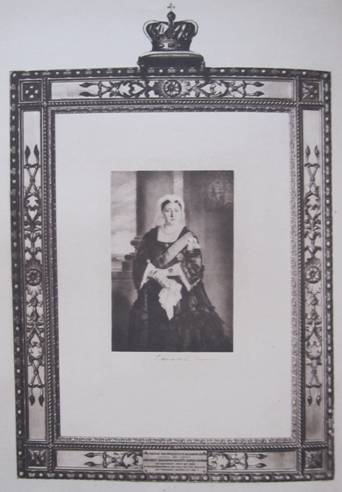
The portrait of Queen Victoria that was presented and signed by her following her first visit to Beaumont in 1882.
History of the estate
Beaumont was once called Remenham, after Hugo de Remenham, who held the land at the end of the 14th century. After a period in the ownership of the Tyle family, the estate was successively occupied in the 17th century by John Morley, Francis Kibblewhite, William Christmas and Henry Frederick Thynne, who was clerk to the Privy Council in the reign if Charles II.
In 1714 it was inherited by Thomas Thynne, who was created Lord Weymouth, and 30 years later it was bought by Sophia Duchess of Kent. At that time the grounds extended right down to the river. In 1751 the Duke of Roxburghe purchased it for his eldest son, the Marquis of Beaumont (then a boy at Eton) and renamed it Beaumont.
In 1786 Beaumont Lodge acquired its most celebrated tenant- Warren Hastings, the first Governor-General of India. "I have bought a very pleasant little estate of 91 acres at Old Windsor called Beaumont Lodge," he wrote to a friend. It cost him £12,000.
His trial in the House of Lords on charges of cruelty and corruption in India had started six months before. It was to last seven years, and end in his acquittal. He only lived at Beaumont for three years however. In 1789 he sold the estate, which included the Bells of Ouseley public house and the adjoining Duncalves Close to Henry Griffith, an Anglo-Indian. Griffith pulled down the Beaumont Lodge building, which had stood for about 100 years, and engaged an architect named Henry Emlyn to erect the house which still stands, and which the boys of Beaumont knew as The White House.
Emlyn comprehensively redesigned and extended the house turning it into a nine bay, more classical villa. He had pioneered the design of the ‘Brittanic Order’, characterised by double-thickness columns at the base of the shaft, which then split part way up the shaft to become two columns, with oak leaves and the Star of the Order of the Garter making up the column capitals. Very few examples of this Order now survive, which adds to the significance of the Beaumont Estate, though in this case the foliage is replaced with Prince of Wales feathers within the column capitals, with the Garter insignia instead being applied to large escutcheon shields attached to the columns.
In 1805 Beaumont was bought for nearly £14,000 by Viscount Ashbrook, who was a friend of George IV. He built Ouseley Lodge on Duncalves Close for his son-in-law Captain Every. After his death in 1847 his widow disposed of the Bells of Ouseley but lived at Beaumont until 1854, when she sold it to the Society of Jesus.
The following five drawings depict Beaumont as it was built by Henry Emlyn F.S.A. ”an architect who, if he failed to produce a masterpiece, has at least produced a curiosity which is absolutely unique”. It was certainly much liked by artists during the late 18th and early 19th centuries.
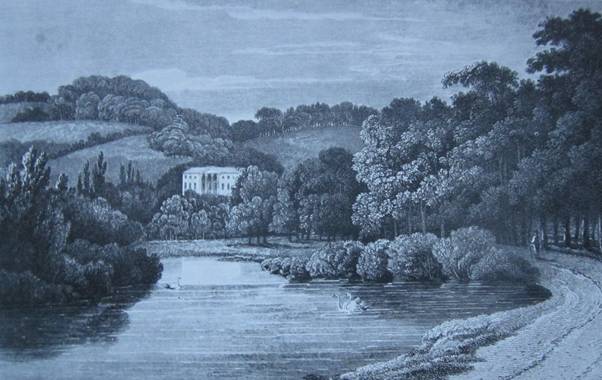
Beaumont Lodge drawn by John Hakewill who painted many of the great houses of England in the latter part of the 18th century. This is the earliest depiction of what became known as the White House.
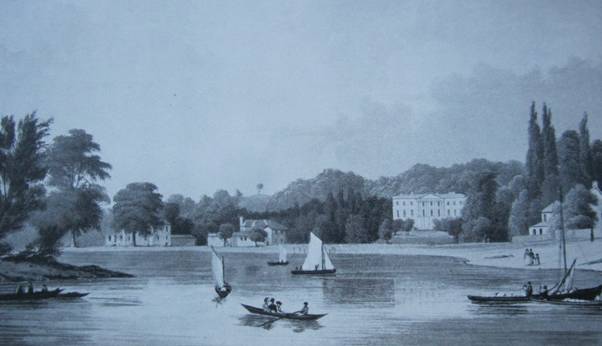
By William Westall A.R.A. best known for his landscape paintings of Australia and his “artistic licence” in his paintings. The period is about 1820.
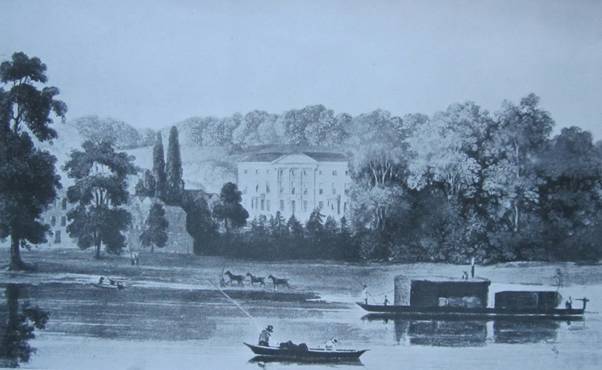
By John Gendall, an artist often associated with Ackermanns and their early work with lithographs.
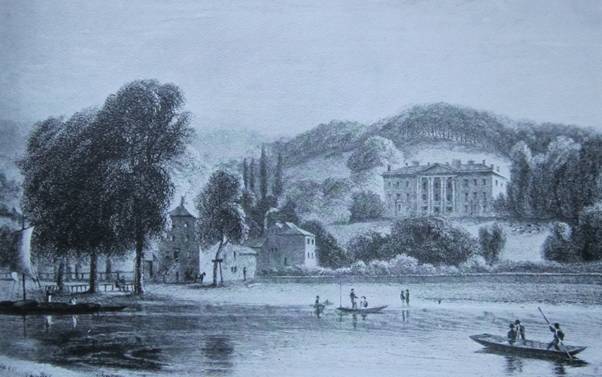
By William Daniell R A, landscape and marine artist, well known for his aquatints. He produced several works of Windsor Castle and also worked extensively in India.
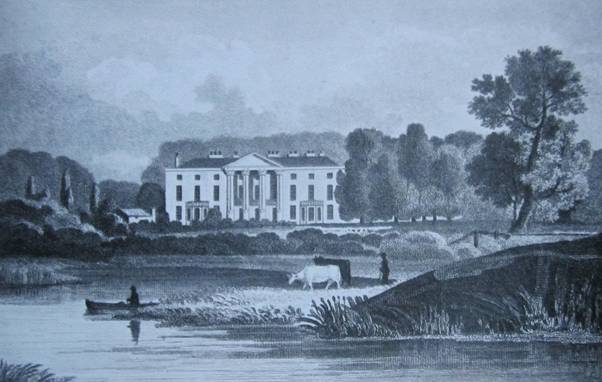
By John P Neale an architectural and landscape draughtsman popular with engravers.

The Bells of Ouseley in 1820.
Vulgarly called the Bells of Bosely or Bouzely; this house was originally built for the accommodation of bargemen, and others navigating the river Thames between London and Oxford. It has a sign of six bells, i. e. the bells of Osney. It was the adopted “watering hole” of the Beaumont Union sporting Clubs and the BU Fascist Group of the 1930s.
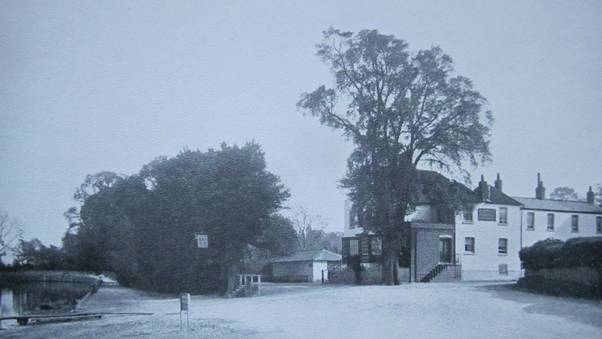
1885: Dickens's Dictionary of the Thames:
"Bells of Ouseley", a tavern on the Berks bank, at Old Windsor; about a mile below the lock, and close to Beaumont Roman Catholic College. Good accommodation can be had, and the house is noted for its ale. The scenery here is very pretty ...
The original Inn was burnt down in 1936 and rebuilt.
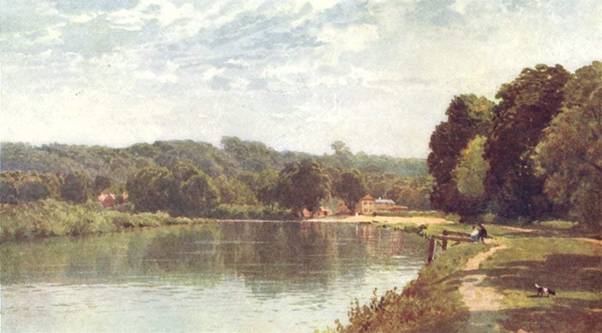
The Bells and the Beaumont Reach in 1908
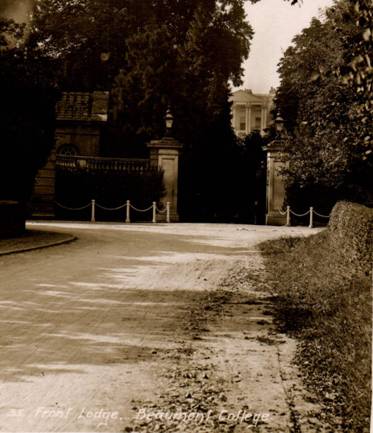
The lane from The Bells past Ouseley Lodge to the main gates.
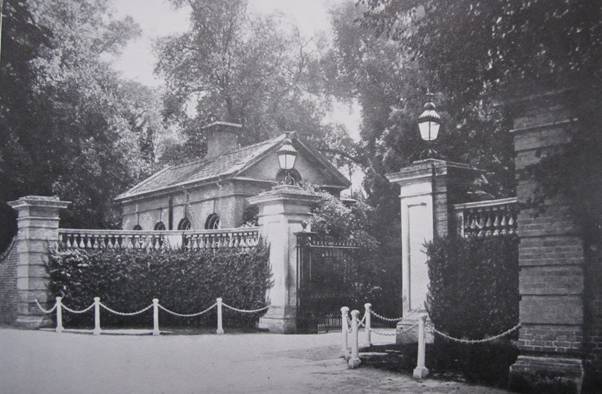
The Gate Lodge and main gates.
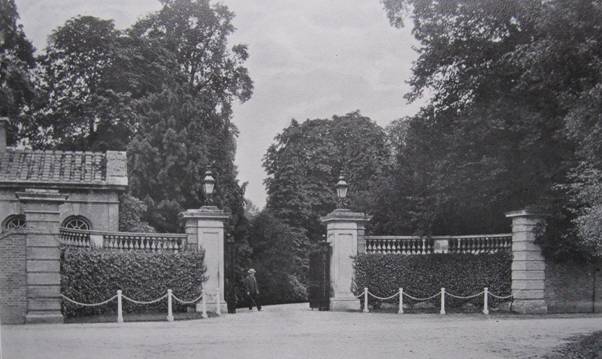
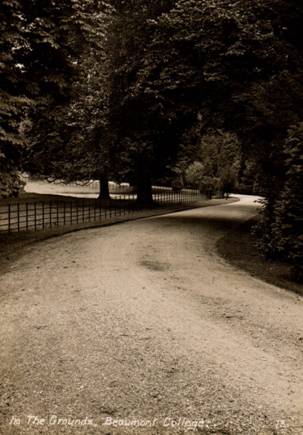
The main drive curved in a serpent up to the White House.
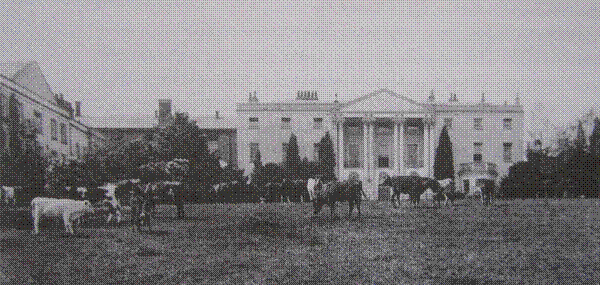
1880
There were cattle from the home farm in the meadows from the opening of the school up until its closure.
Architectural note.
It was under the School’s ownership that the Beaumont Estate site underwent its first significant phase of development. The original plans for a magnificent Chapel in the Gothic style by the first Rector Fr Eccles with a chancel of over 140 ft came to naught: the foundations were laid but it remained a dream.
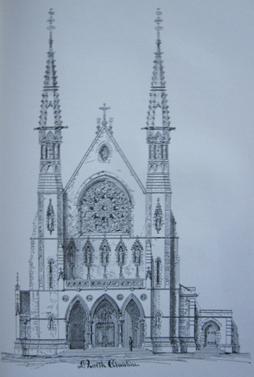
Economy and retrenchment were the order of the day and in its place an equivalent three storey brick Chapel was built to the northeast of the house in 1870, executed to a design by Joseph Hanson. The Theatre or School Hall was built beside it. There are indications that Hanson also carried out adaptations to the house itself at this time, principally in relation to connecting it satisfactorily with the new wings to the southeast, which were also constructed in the 1860s/70s.( Refectory, playrooms with classrooms and dormitories above). These south eastern extensions appear to have been designed in at least three phases, possibly four, based on their varying architectural design. Ultimately however they collectively create a large L-shaped extension range to the house.
It may be that parts of the L-shaped south eastern range were designed by Hanson as part of an ongoing design role at the site, recognising that some design details found in these ranges are consistent with those of the Chapel, notably the round-headed windows, evidence on this is not as yet conclusive however.
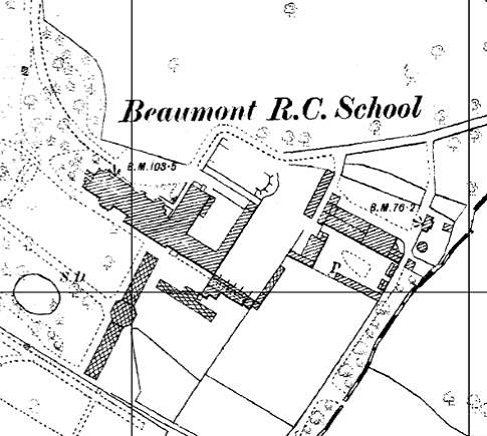
1896. Note that what became St Joseph’s Quadrangle was at the time an open space and the large glasshouses (Ambulacrum) to the south of the main buildings.
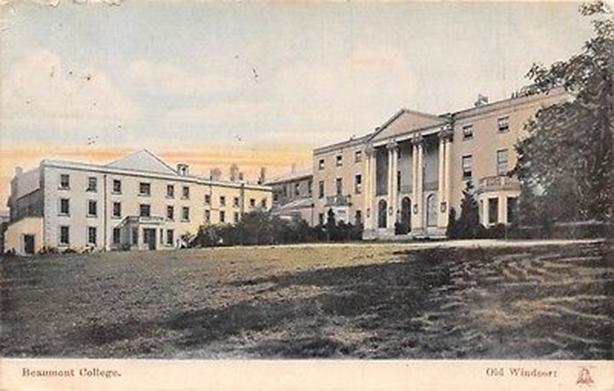
1907
The Chapel and Theatre block was built in 1870
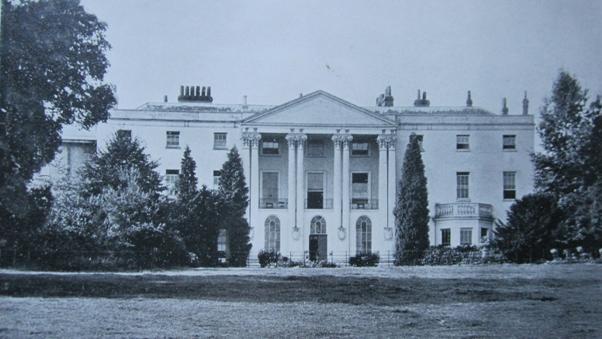
1911
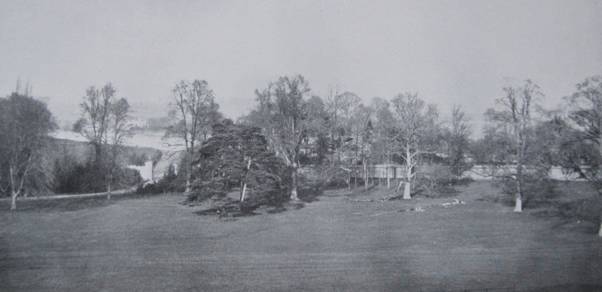
View from the White House to the main gates and the river.
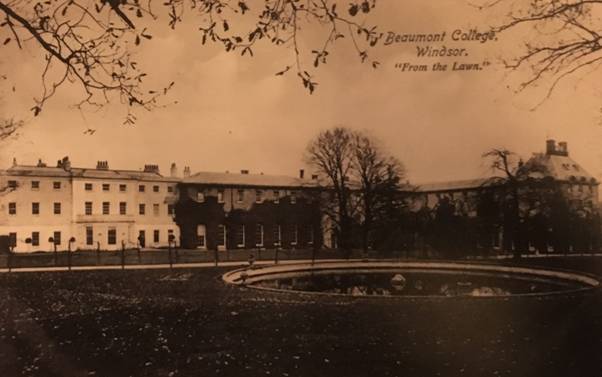
The Back or Captains’ Lawns
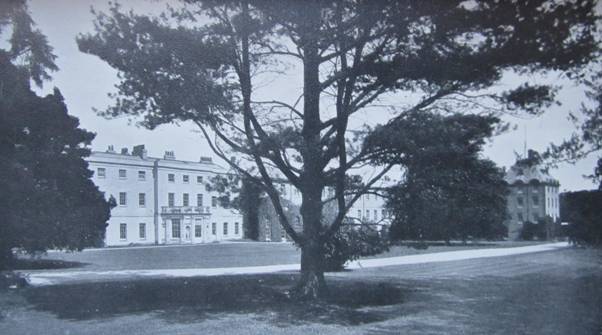
The first or Hanson extension off The White House in 1865 as the school started to expand.
The construction of the Wing (Library, Community etc) was started in 1876, it eventually necessitated the demolition of the two large glasshouses which had historically occupied this part of the site. The landscape and pathways in this part of the grounds were also redesigned to respond to this extension.
The 1896-1899 period also saw further notable building added along the east elevation of the College, with the space between the Chapel and the service courtyard (St Joseph’s) also being infilled at this time.
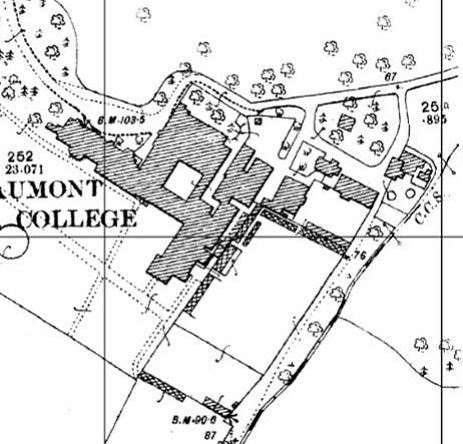
Map showing the site in 1899 with the constructed wing that was eventually Higher line, Library and Old Community Block and the infill around St Joseph’s Quadrangle.
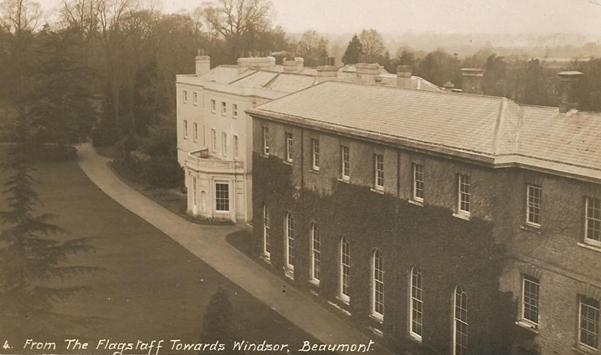
The Hanson extension to the White House begun in 1865
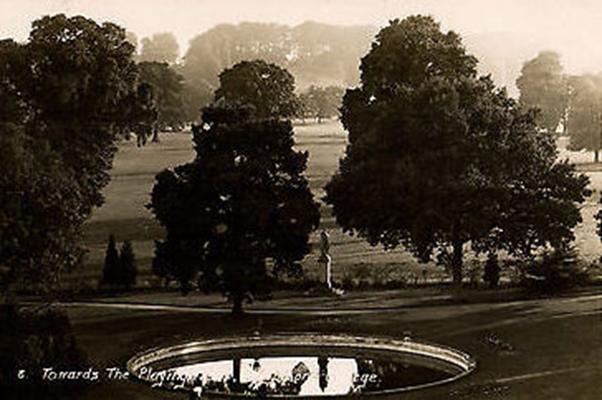
The Pond in the Captains’ lawn
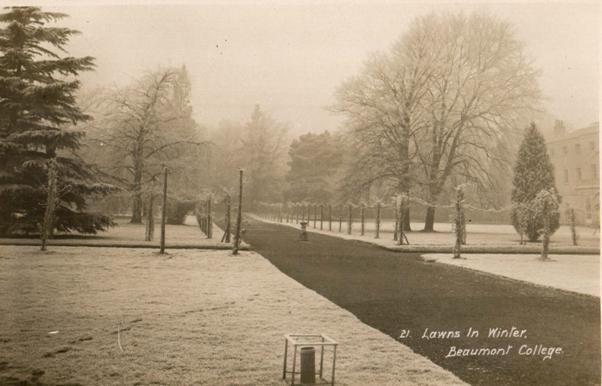
Espalier trees lining the gravelled way to what was to become the site of the war Memorial.
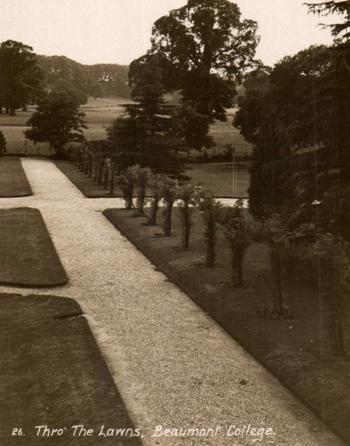
Another view looking south towards the cricket Grounds and The Beeches.
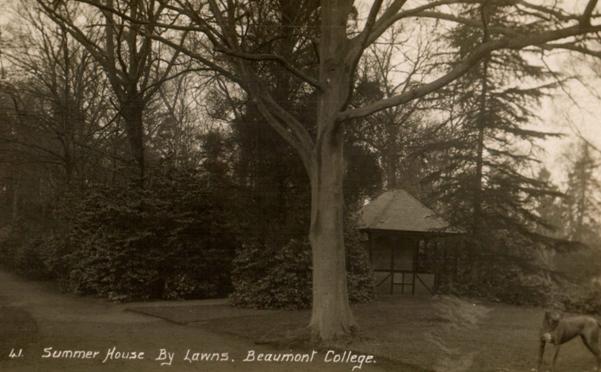
The Summer House long since demolished. The dog on the right could be Queenie or Remus one of several dogs over many years that had the run of both buildings and grounds and were firm friends of both masters and boys alike.
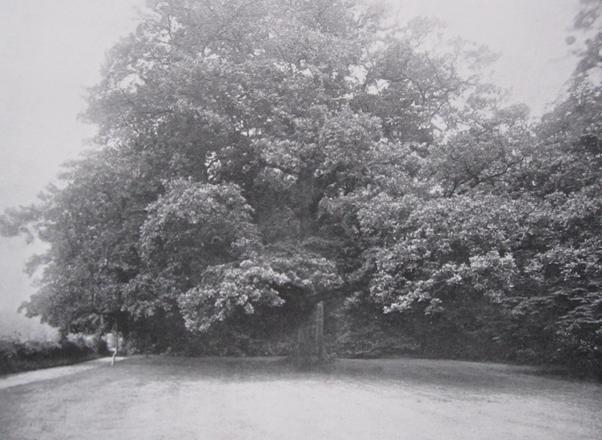
The Corpus Christie Oak: the site of the Grand Academies with speeches from a marquee donated by Hon Gerald Dillon which also served as the cricket pavilion up until 1882. The Oak was so named for the Homily preached there on the feast day each year and the destination of the procession of the Blessed Sacrament.
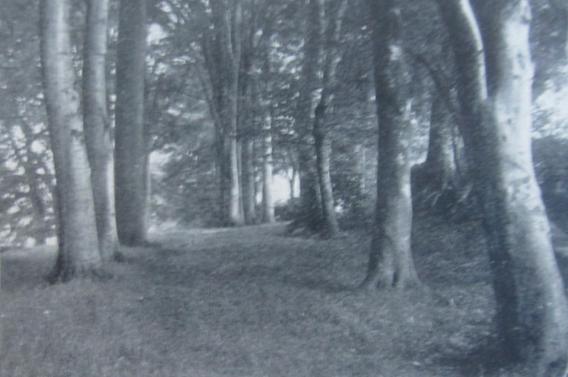
The Ghost Walk
Capt. Frederic Cournet French Navy killed by a compatriot in the last duel in England 19 Oct.1852 close to the Beaumont Farm and is said to haunt this path through the woods
“Thus runs the tale in Beaumont lore, and mystery has ever hung around this spot where flow’rets fade, where ne’er has thrush or linnet sung, in sombre shade the walk is clothed, and when at ev’n the shadows fall, here reigns the silence of the tomb ‘mid gloomy precincts shunned by all”
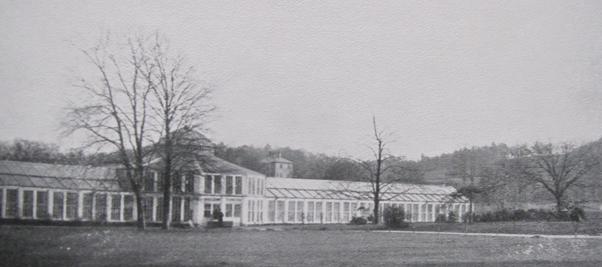
The Glass House or old ambulacrum that was demolished in 1889 to make way for the Building extension. The sanatorium can be seen in the background.
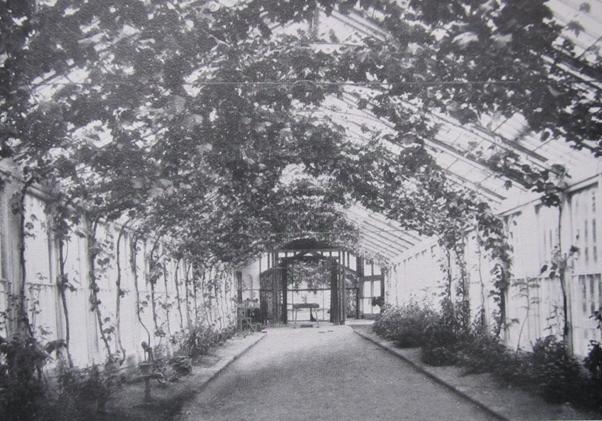
The inside of the Glass house showing the grape vines.
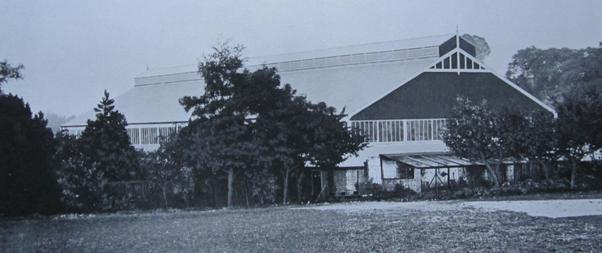
The Jubilee Hall or new Ambulacrum built to mark the first 50 years of Beaumont in 1911. To be used for indoor games, Corps parades, receptions and Speech Day.

The Dairy which adjoined the farm was built by Fr Cassidy in about 1880.
Later the building would become the Laundry and then redeveloped into the “Old Laundry Dorm”.
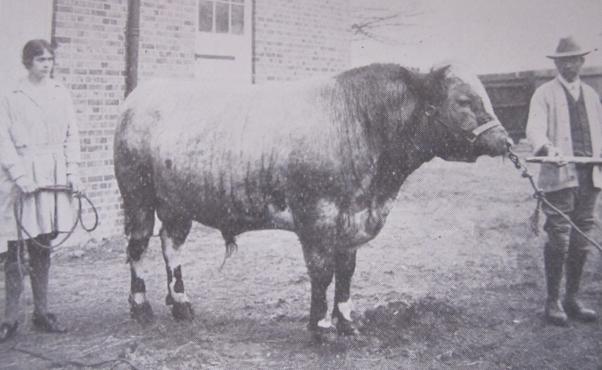
Billy the pride of the Beaumont Herd
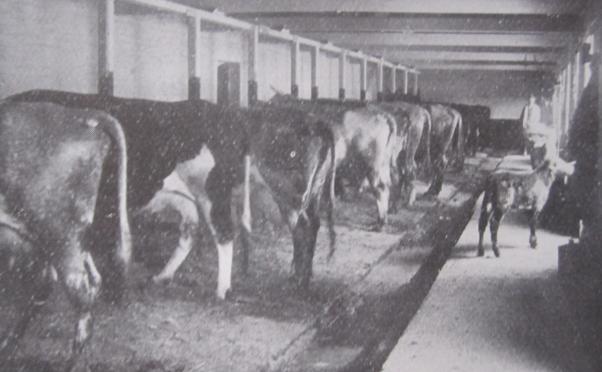
The Milking Parlour

Another view of the Dairy some 20 years after planting had been carried out.
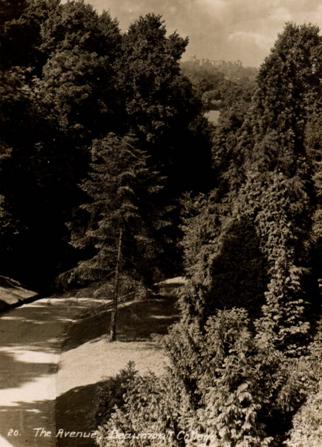
The Avenue or main drive with the view of the Castle from the White House.
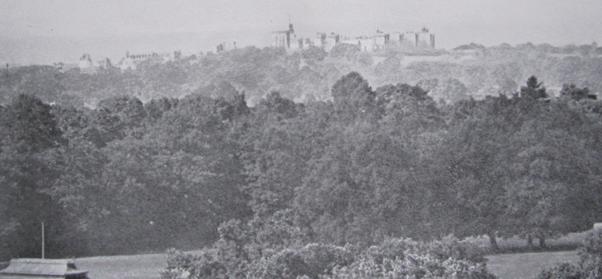
Another View of the Castle taken from St John’s with the top of the Cricket Pavilion in the foreground.
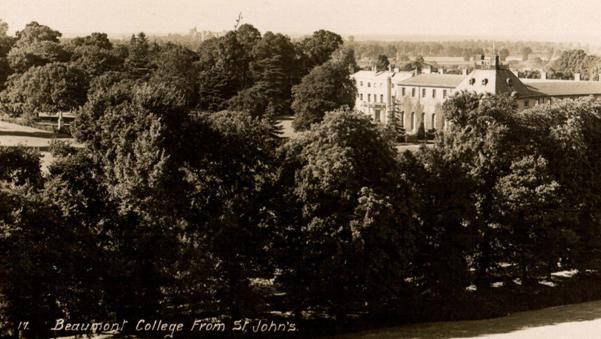
Although the caption says from St John’s it is more likely from the angle that it is from the top of the old Sanitorium.
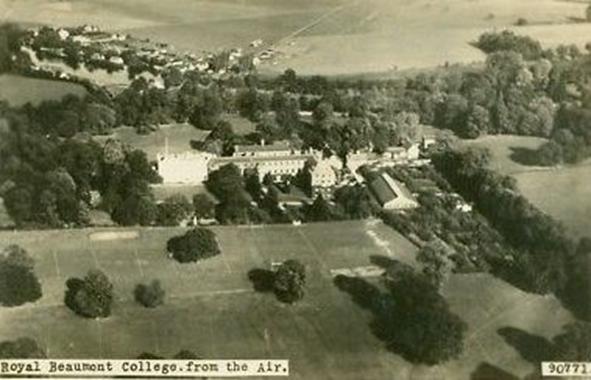
An early aerial view of the College.
Although it might have been appropriate to be granted the title “Royal” in view of the School’s connections, it would have caused consternation among followers of the Established Church.
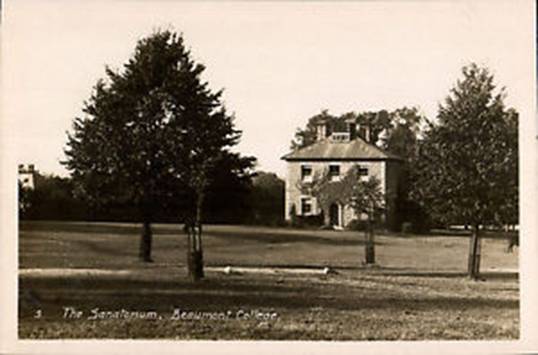
The Old Sanitorium close by to the site of St John’s.
Well away from the main school it provided isolation for the sick and infected when illness brought about the death of several school boys particularly up until the Great War. It was replaced by the Infirmary Wing built by Adrian Gilbert Scott just before WW2.
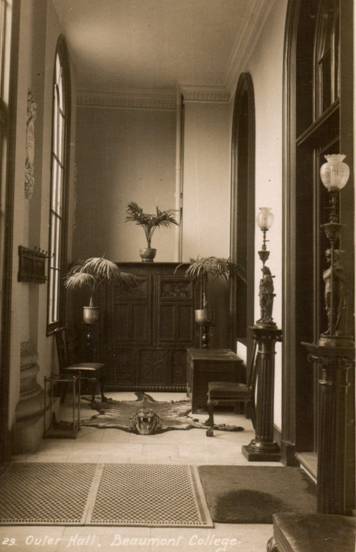
The Entrance Lobby to The White House
In the Edwardian period, tiger skins and other big game trophies shot by OBs decorated many of the rooms throughout the school.
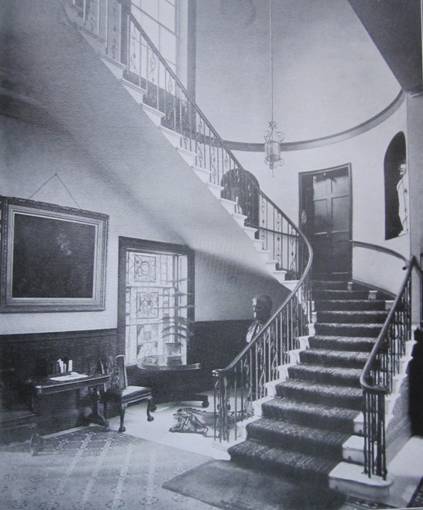
The main hall with the staircase that led to the original Community accommodation. It later became the home of the Preparatory classes until St John’s was built. The entrance to the Sodality’s Chapel halfway up on the right. The stained glass contain coats of arms that were originally in the old Glass house.
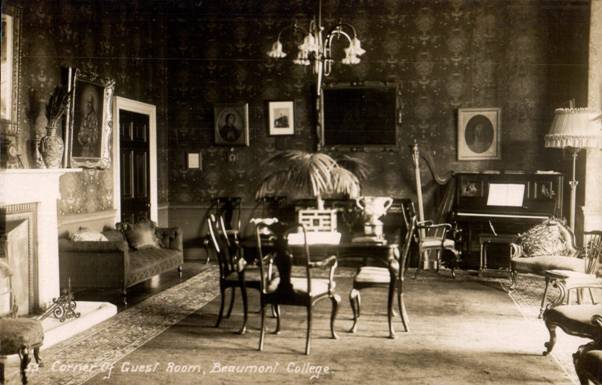
Also from the Edwardian period – the First Guest Room that was redecorated and refurbished over the years according to the taste of various Rectors but always retained that homely grandeur of a great house.
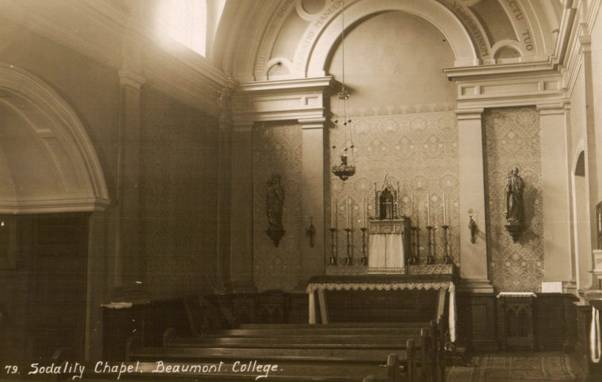
What was to become The Sodality Chapel within The White House after 1870. Originally a library, It was redesigned with a Romanesque arched ceiling to become the place of worship in the first 20 years for the Community up until the building of the School Chapel.
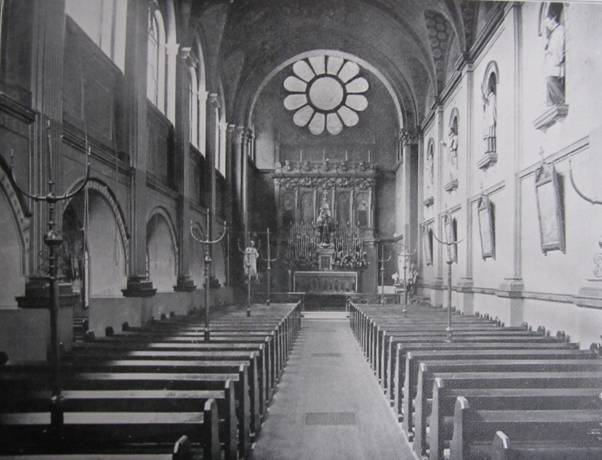
Hanson’s chapel that was built in 1870 and austere in comparison to what had been originally proposed. It remained in this form till redecorated in 1902 by Romaine –Walker in the style of “the grand-child of Pompeian that in the exuberance of its youth throws off much of the reserve and formality of its forebear”
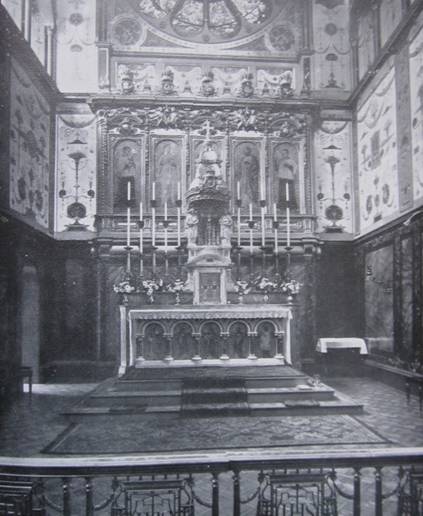
The Romaine Walker decoration.
The style the grand-child of Pompeian throws off reserve in its exuberance of youth. The Barrell vault of both the nave and sanctuary is richly decorated with marbling containing biblical plants, birds and Raphaelesque ornaments. There are also representations of Faith, Hope, charity, Purity and Confession. The walls have medallions bearing the heads of St Gregory the Great, St Edward the Confessor, St Thomas of Canterbury, St John Fisher and Thomas More and Edmund Campion.
The reredos, given by the Beaumont Union, designed by Bentley, and painted by Nathaniel Westlake contain: The Divine Lord, Our Lady, St Aloysius, St joseph and St Stanislaus.
The Stations of The Cross are copies of those in Antwerp Cathedral (form part of the Boer war Memorial).
Among the donors to the Chapel were Gen Guzman Blanco President of Venezuela, Lady Williams Bulkeley The Duc de Stacpoole, The Duchess of Madrid, Don Carlos of Spain, Sir Humphrey de Trafford, Mrs Washington Hibbert, Hon Mrs Oliphant, Sir John Errington, John Mackay, Duke of Santona and William Plowden Esq.
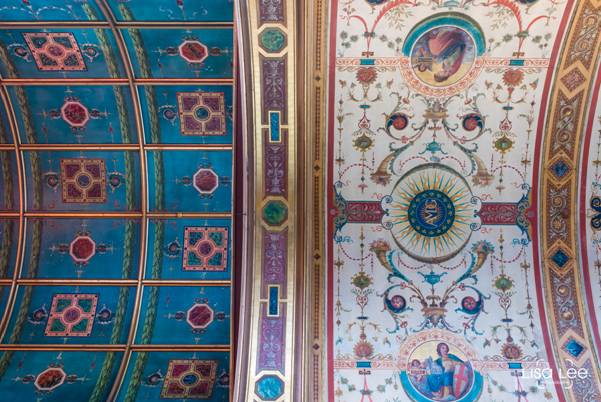
Detail of The ceiling
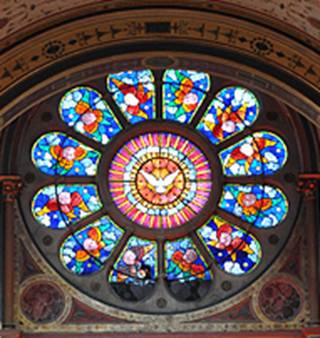
The Rose window of The Holy Ghost
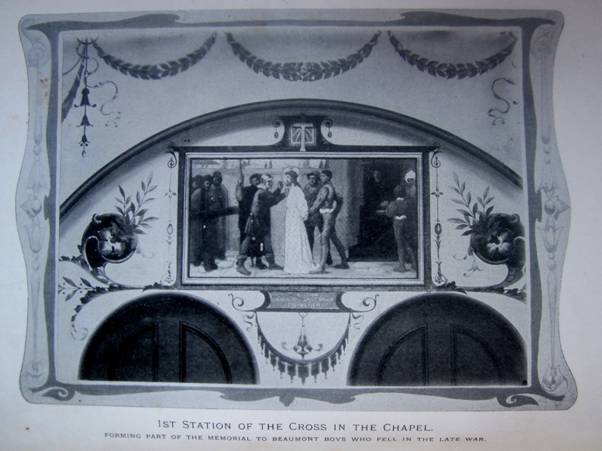
The Stations of The Cross were copied from those in Antwerp Cathedral and formed part of The Boer War Memorial. The Originals were painted between1864-1868, in a historic realistic style by Louis Hendrix (stations 1-4, 12-14) and Frans Vinck (stations 5-11). The narrative character of the passion is supported here by a continuous background, so that each scene becomes a part of an uninterrupted serial story. This way of the cross was so successful that copies were made, including those at Beaumont.
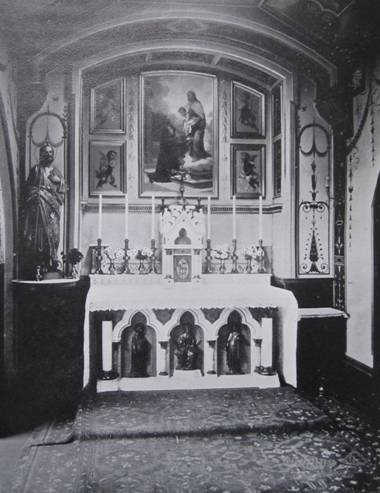
The Altar of Our Lady and St Stanislaus
Formerly in the private Chapel of Mrs John Mackay together with the paintings that were brought from Rome. Mrs Mackay was the wife of John Mackay one of the wealthiest men in late 19th century America. Their two sons were at the School. (This Altar is now the main altar at Stonyhurst)
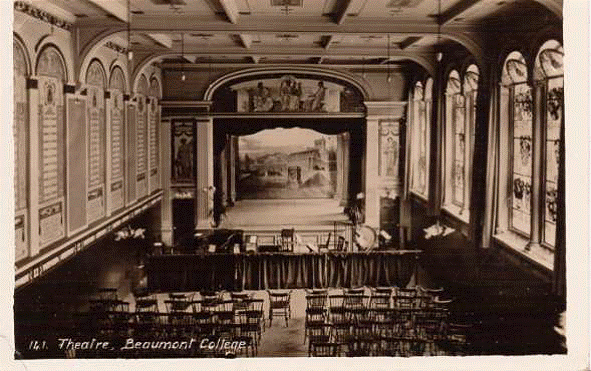
The Theatre with its Classical frescoes , stained glass with the armorial bearings of OBs, the lists of Captains of the school was the scene for all levels of plays including the Beaumont Union. Boxing Tournaments, unlike any other school, were also held in the theatre.
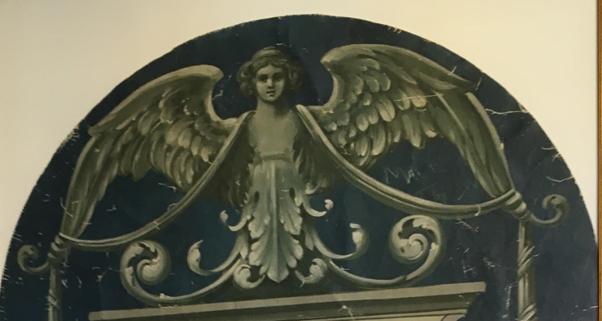
Theatre decoration detail
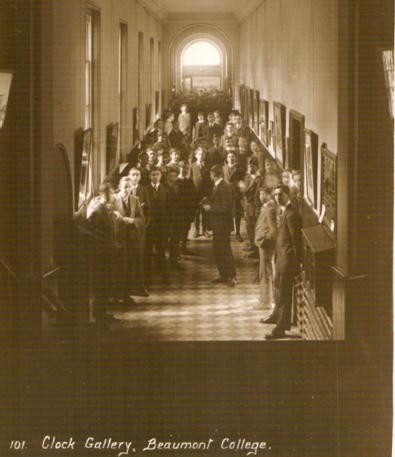
The main or Clock Gallery off which was “The twopenny” Tube to the Theatre (Hall) and the Chapel.
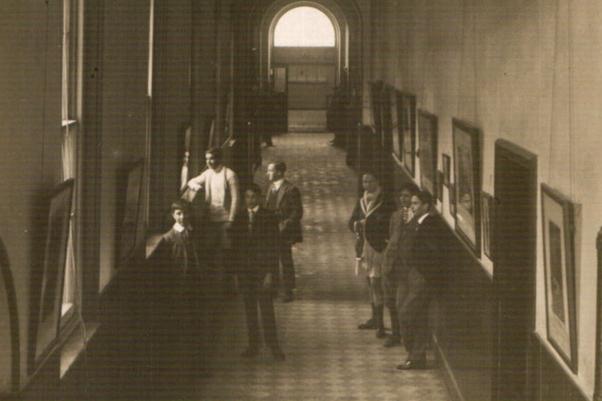
A further view of the Main Gallery
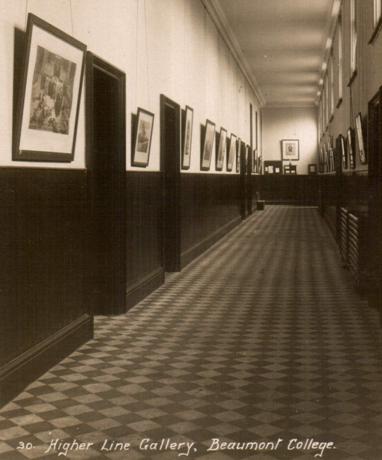
The Higher Line Gallery leading to the Library Music rooms and the old Community Wing. The Pictures would later be exchanged for 1st Team photographs. Members of Lower Line using the gallery had to march down the centre.
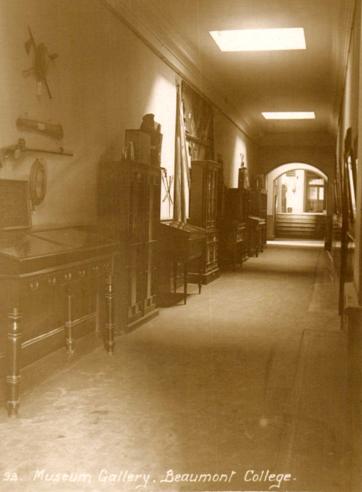
The Museum Gallery leading to the White House: All the artefacts were removed probably in the 1920s
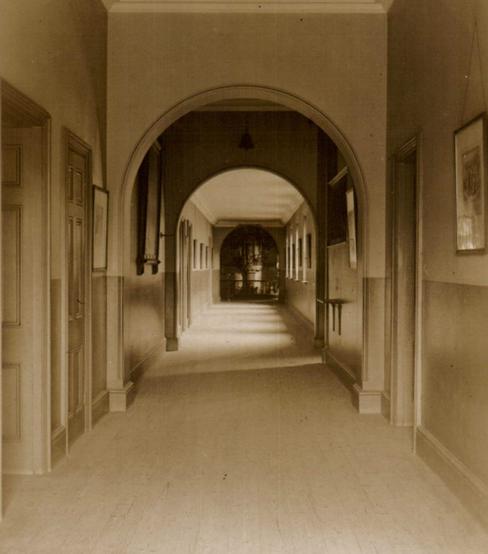
Classroom Gallery on the first floor looking towards The Lady Altar
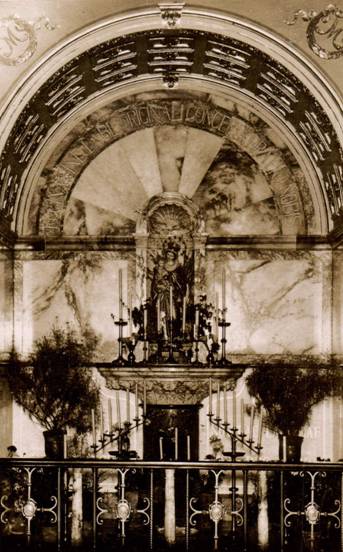
The Lady Altar donated by the Duke de Stacpoole. It later held the crucifix made from the sword of Lt Harry Butters KIA in the Great War.
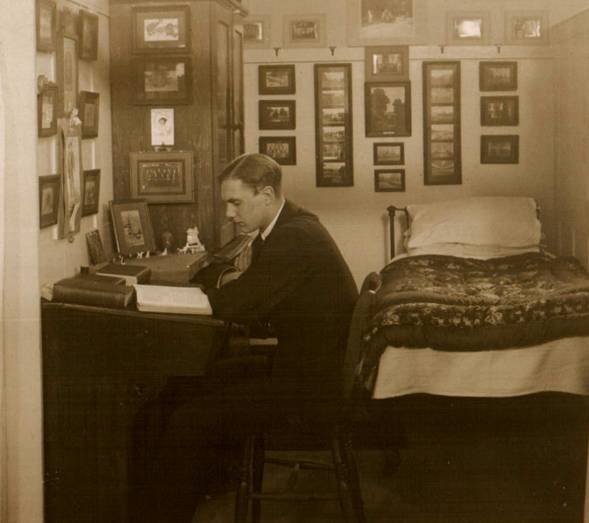
Studies “A” cubicle and study
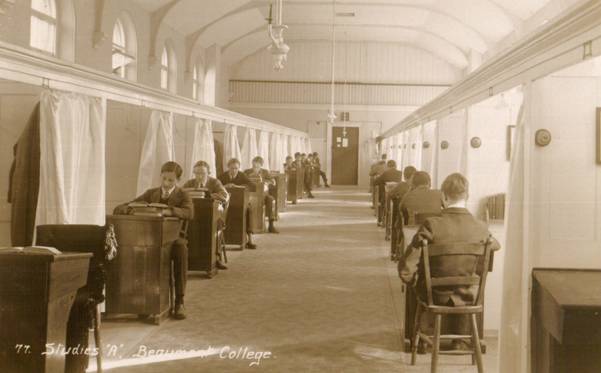
Another View later washbowls in the cubicles were replaced by basins in part of the gallery.
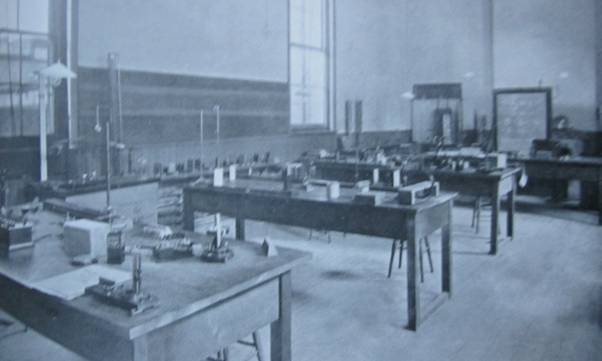
Physics Laboratory:
Sciences were taught from 1869 under Prof. Frederick Barff, Chemist, inventor and decorative artist. The Laboratories were re-equipped in 1901.
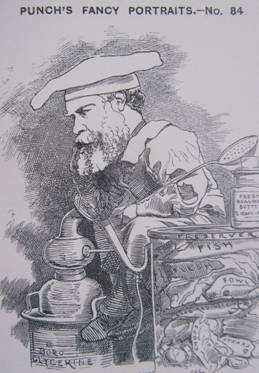
A caricature of Professor Balfe that appeared in Punch 1882. He was the inventor of the method of rust-proofing cast iron and the antiseptic Boro-glycerine.
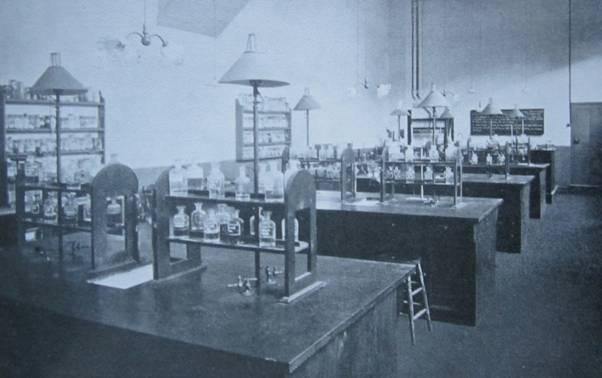
Chemistry laboratory.
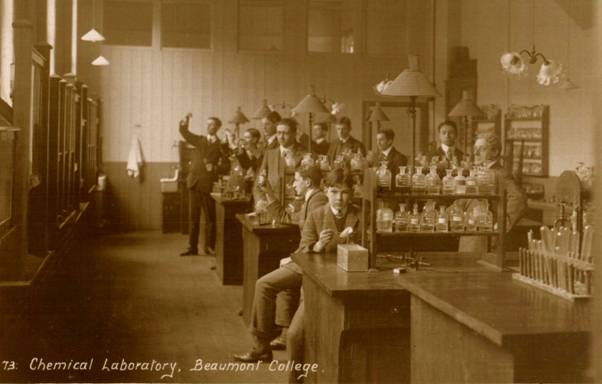
The Physics, Chemistry and Biology Laboratories were moved to a purpose built block in the 1930s.
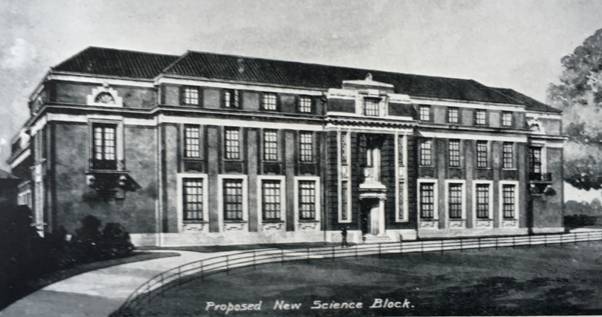
The New Science wing in the “art deco” style
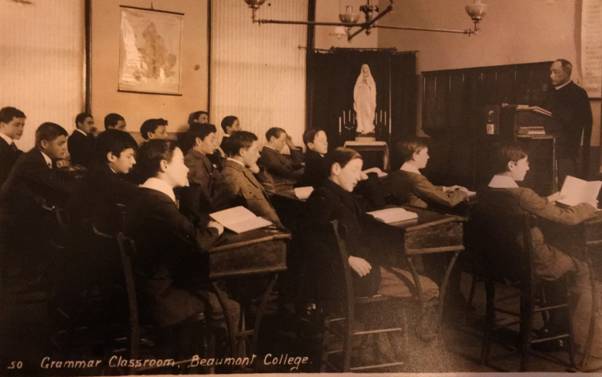
Grammar (2nd year) Class.
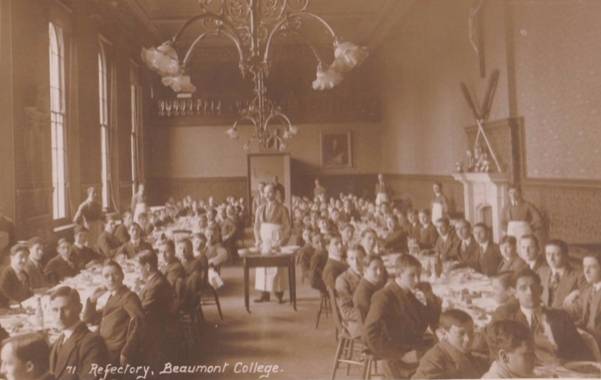
The combined Higher and lower line Refectory and the site of the Boer war Memorial Cartouche and Queen Victoria’s portrait. Crimson William Morris wallpaper was added later
Meals were served by the Head Carver and his staff. As the School expanded Higher Line moved to its own Refectory.
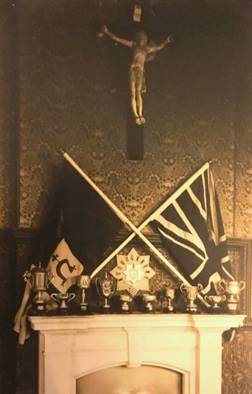
The mantelpiece: here the William Morris wallpaper can be seen together with the Mackay Ivory Crucifix that was carved from one Elephant Tusk.
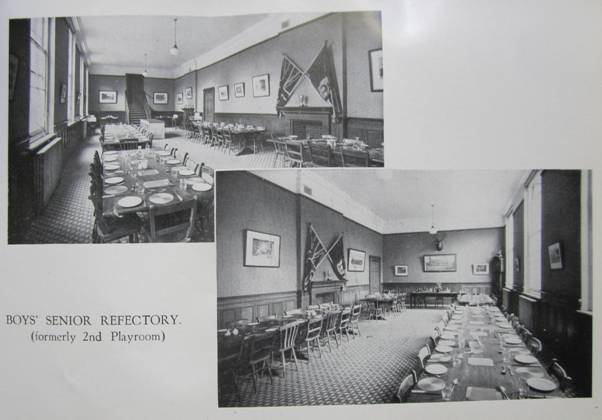
The Higher Line refectory
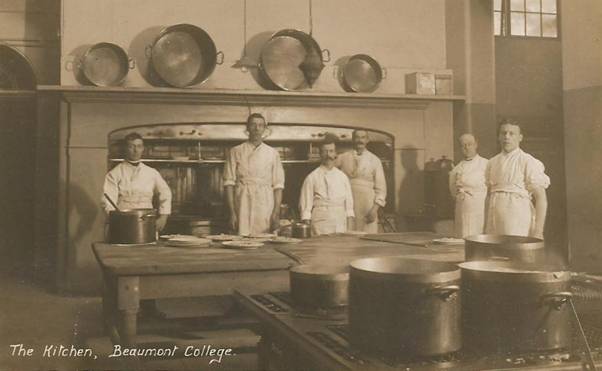
Beaumont was not known for its culinary delights and during the Great War standard reached an all-time low. However the feasting for the 1911 jubilee was reported as lavish and shocked some of the younger parents (who presumably found the cost added to the school account). The accounts were always submitted in guineas.
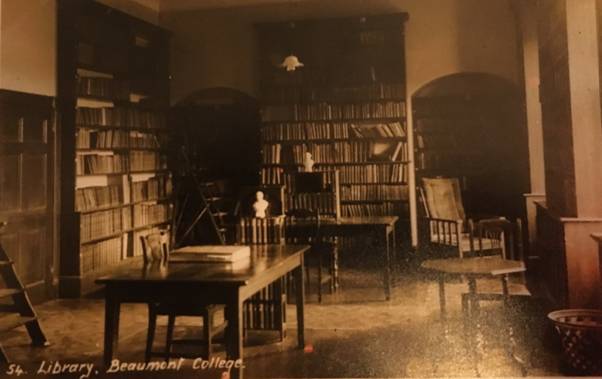
This was the Library (whereabouts uncertain) before it moved to more spacious accommodation off the Higher line Gallery.
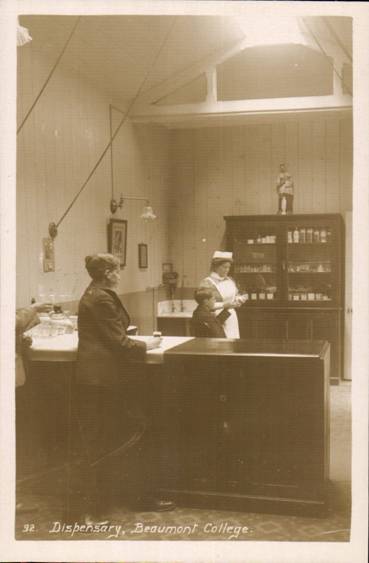
There was a dispensary in the main buildings and a sanitorium for boys with contagious illnesses between the College and St John’s. This was replaced with the infirmary wing built by Adrian Gilbert Scott at the end of the 1930s.
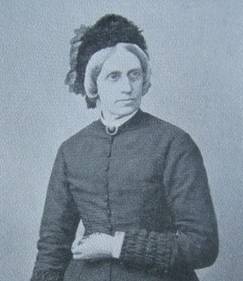
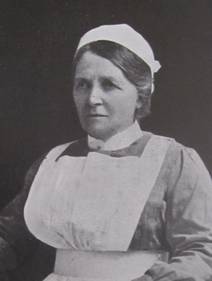
The schools best known and loved Matron was Mrs Hatcher who arrived in April 1862 and served for thirty years: she was presented with a silver tea Service by the Beaumont Union when declining strength forced her retirement. She was known for her “black draught”, “pepsine and aloes” and her “port wine” for sore throats that apparentley burnt well when put on the fire.
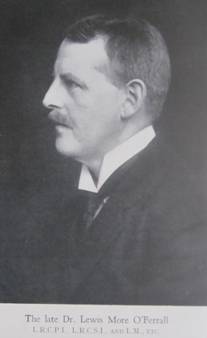
Dr Lewis More O’Ferrall Medical officer 1918 till his early death 1932. He studied medecine in Dublin (double gold medal winner) and in Vienna. He is probably best remembered that despite the Spanish Flu that hit the school so badly 1918-19, no one in his care succombed. His sons were George (24) actor and TV producer and director and Monsignor.Rhoderick (27) National Director Apostleship of the Sea and the St Vincent de Paul Society.
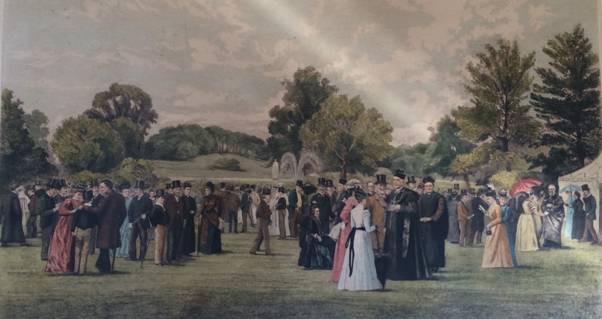
Speech day 1892 which replaced Grand Academies. This depiction was during the Rectorship of Fr Sir William Heathcote Bart (OB) 1891-94 by H. Jamyn Brooks. E.W. Evans. London, Published March 18.th 1892, by Messrs Dickinson & Foster, Publishers to The Queen. 114, New Bond Street,
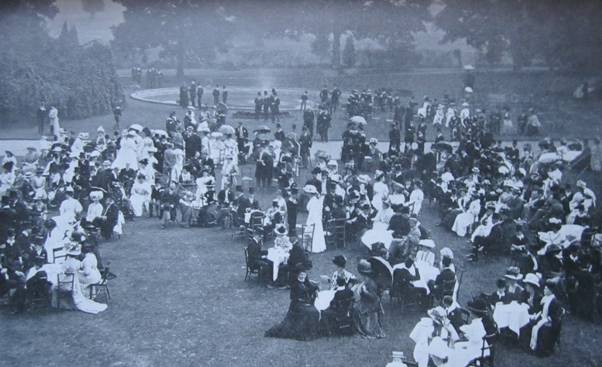
Speech Day during the Rectorship of Fr Joseph Bampton 1901-8
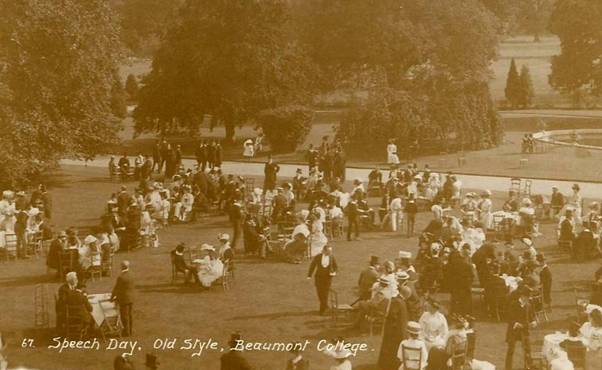
Another of Speech Day before The Great War 1907

The annual Corpus Christi procession: members of the Sodality at the front. The boys from St John in velvet knickerbockers strew rose petals in front of The Blessed Sacrament. The Captains carry the canopy and a Guard is provided by the School Corps.
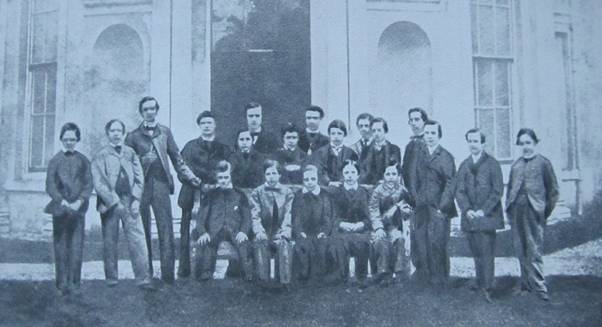
The earliest photograph taken in the 1860s of the boys at the back of The White House.
The School first opened on the 10 October 1861 although the first boy but a philosopher Manuel Pereira did not turn up until the 22nd. Charles Roskell arrived on the 28th followed by John and William Munster a few days later. In January it was William Heathcote and William Gardner who put in an appearance and by July there were 24 boys in total.
Pereira played cricket but died in 1874. Roskell son of the Jeweller and Royal Silversmith became a solicitor in the very Catholic firm of Witham, Roskell, Munster and Weld. William Munster, son of Henry Cambridge Boating Cox, English Cricketer and MP, was also Liberal MP for Mallow, died 1877. John was a solicitor with Roskell. Heathcote became SJ, Rector of Beaumont 1891, 7th Bart 1903. Gardiner played Cricket and “went to sea”
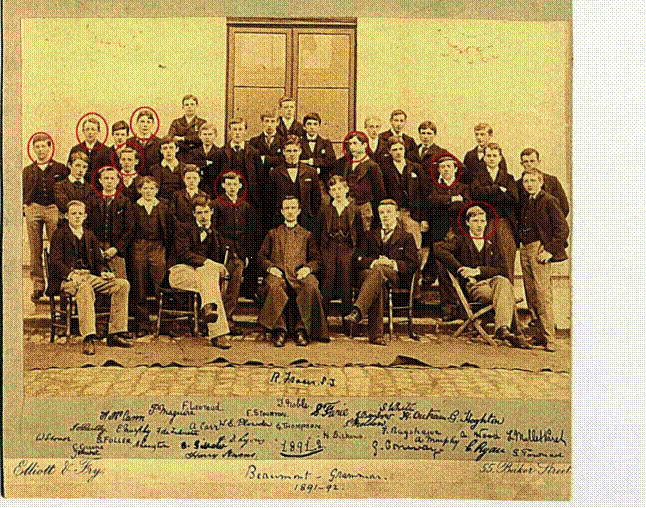
Grammar 1891 -2
F Leotard (Ch. Compagnie Generale Transatlantique). J Noble (Banker Hon Sec BU 1914-36) S White (Lloyds underwriter) J Maguire (Trinity Camb.) Hon E Stourton (Col. KOYLI DSO) S Farie (D O Borneo) ---------- W Outram (Lt Essex. Merchant Trader) G Hoghton (Capt. RFC) J McCann (MFH, Olympic Silver Polo) A Carr (Solicitor) W Plowden (RIP Plowden Hall ’97) G Thompson (Aus. Paget’s Horse) F Bagshawe ( Senior Commr. Tankanyka CMG MBE) A Wood ( Col Scottish Rifles) E Mallett Vaughan ( Maj. Grenadiers DSO) J O’Reilly (Irish Footballer) E Murphy ( Engineer) F de Zulueta ( Prof Civil Law, Ox. Fellow) H Dickens (Sergeant in Law Alderman OBE) A Murphy (Cork) W Stonor (Engineer India) C Greene (RN, Engineer) B Fuller (Col. Dorsets) W Langton (Trade Commr. West Indies) G Gillow ( Ch. Cabinet Makers) J D Lyons ( Capt 13th Hussars HS limerick) Seated; J Tolhurst (Engineer) H Stevens (Merchant Naples) Fr ? SJ. G Conway (Cape MR, Uganda) C Ryan (Maj. Essex KIA 1916) G Pownall ( Artist, Mosaics Westminster Cath.)
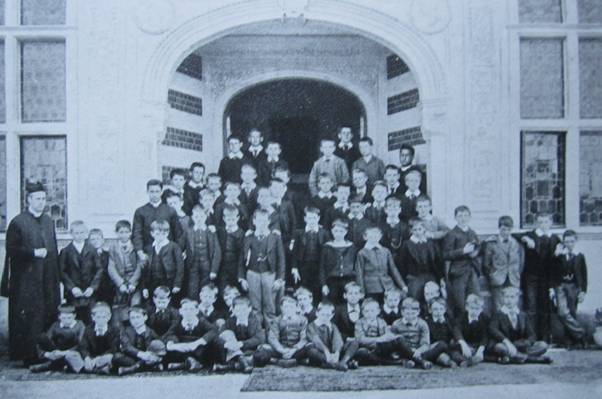
An early photograph of boys taken in 1889 at the newly opened preparatory of St John’s
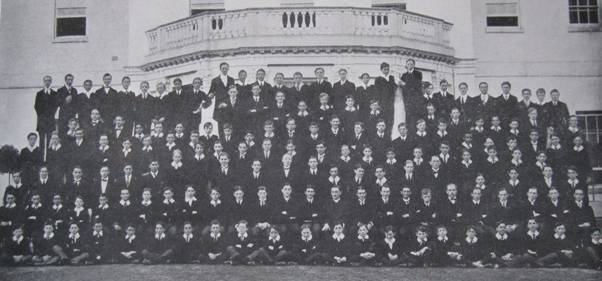
The main School in 1911 Jubilee year with 150 boys
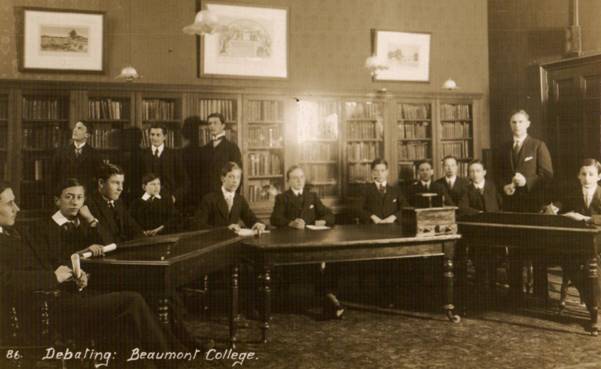
Since the school opened, Debating was an important pastime for the boys.
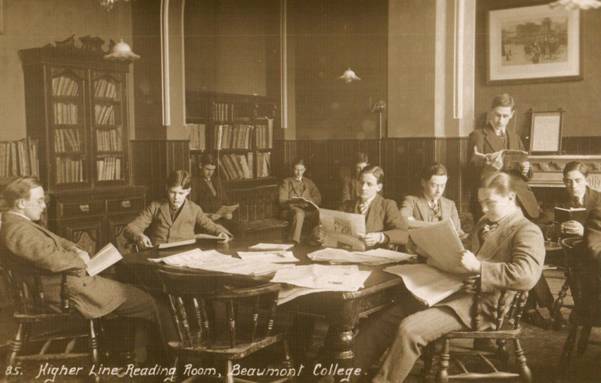

1911
Hallinan to Jesus Cambridge for medecine, WW1 major Munsters, MID, WDD. ( his 2 son in laws Ld Manton and Thomas Magnier rmost influential in racing). Munster Balliol Oxford, WW1 Capt 13th Hussars, KIA Kut 1917. De Lisle, WW1 Capt. Grenadiers, WDD x2, Sq of Garendon & Gracedieu. Harold, Univ. Coll. Oxford WW1 RFA then RFC pilot KIA 1918. Considine son of Sir Heffernin, WW1 Br. Red Cross Ambulance, Canada fox farming.
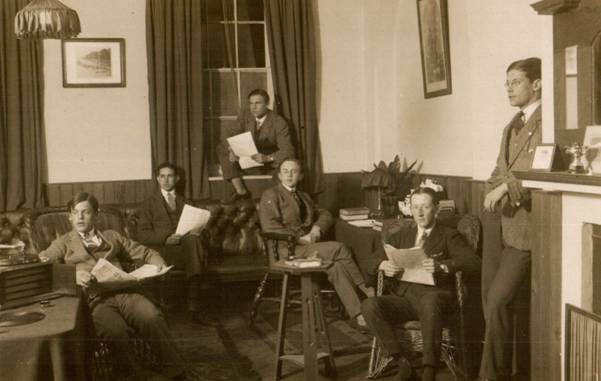
Captains 1913-14
The future Fr Sir Lewis Clifford Bart SJ, Rector of Beaumont is seated on the far left.
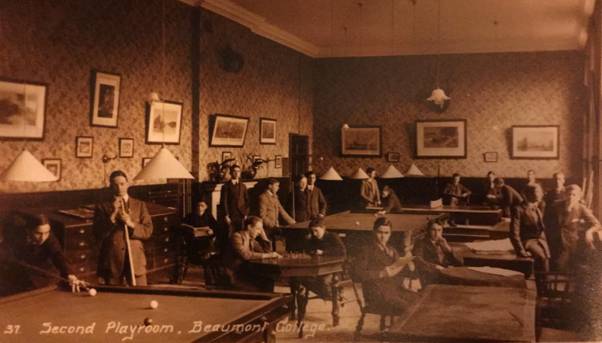
Second Playroom for those in Grammar and Syntax. Aged between the ages 14 to 16 and the senior playroom of Lower line.
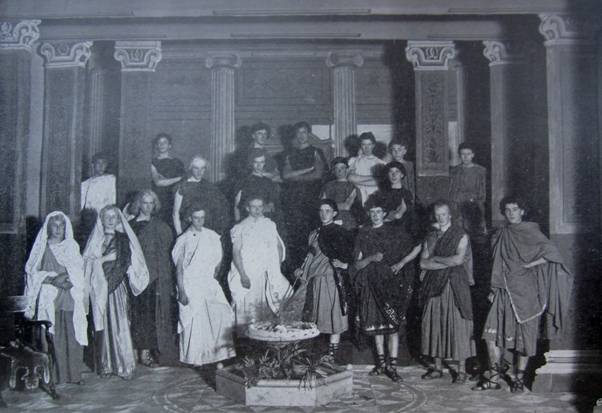
The Phormio
Performed in Latin in the newly decorated theatre 1907. The Theatre Proscenium was in white and gold with the central panel depicting Homer seated, with Virgil and Dante on either side.The two side panels contain life-size figures of Melpomene, the muse of Tragedy, and Thalia the muse of Comedy. The panels along the walls which faces the windows tell of the honours gained by boys, past and present while the windows contain the armorial bearings of various Old Boys. The colour scheme is blues and greys above with warmer reds below. The old act-drop presernted by Sir Humphrey de Trafford in 1892 was felt to be no longer in keeping ( scenes of the chase) and was replaced by one depicting Oedipus and the Sphinx.
Main players B Watkins (Australian, Merton Ox. Layer Sydney). J Holms ( Gs Ld Russell. Corpus Ox, WW1 Capt London Regt. KIA 1915). C Rose-Innes (WW1 Capt Rhodesia Regt, Asst Commissioner and Magistrate Rhodesia). D FitzGerald (son of Hon Eustace ’78, Stockbroker, WW1 Capt IG wdd), L Cary of Tor Abbey ( Univ. Coll. Ox. Law, WW1 Lt Devonshires KIA 1916). Ladies – I Stuart-Gunnis (WW1 Lt Greanadiers KIA 1917) & P Myburgh ( Woolwich, RA, WW1 wdd, MC, DSO. WW2 Brig. DSO, CBE). Interpreter G Ogilvie-Forbes (Univ Bonn, New Coll. Ox. WW1 Capt Scottish Horse Wdd. Diplomat & Ambassador KCMG).
The play received “hearty and spontaneous applause”.
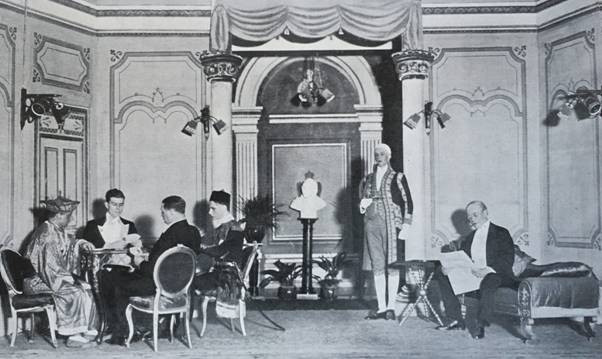
A Lower line play
The staging of comedy and tragedy at Beaumont was designed first and foremost to develop the confidence and learning of the boys - but also to advertise a superior education and product. A notable amateur Irish actor, William Bernard Campbell cut his teeth at Beaumont in 1883 with the lead role in 'William Tell.' A great deal of expense was accrued in the staging of these somewhat elaborate productions. Vast sums of money were expended on drama. For the staging of 'Macbeth' in 1899 the scenic artistry was done by I T. Bull and Sons, the costumes designed by C. and W. May, and the perruquier was W. Clarkson of London." No expense was spared, the public nature of the performance meant that Beaumont would have to produce something worthy of its reputation, and usually did. A production of 'Macbeth' in 1882 was rapturously received by the 200-strong audience, eulogised by The Spectator, and enthusiastically applauded by the several Eton masters that had attended it.
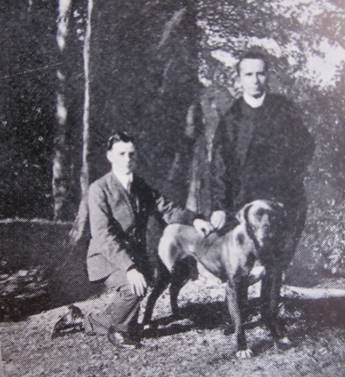
Bevan Harold known as “Beavor” in WW1 KIA Pilot RFC with OB Fr Francis Devas SJ later Chaplain to the Inniskilings, DSO, OBE, MID. Of whom it was written by his Divisional General “I don’t know whether to Court Martial Fr Devas or recommend him for the VC”. The dog is Queenie one of a long line of much loved pets and mascots at Beaumont
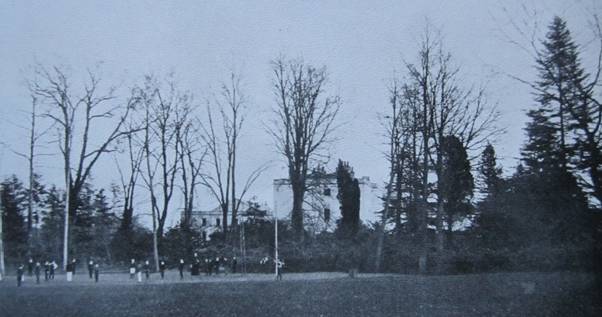
The original Sports / games ground beyond the White House.
The Ground has been set out for a “Grand Match “- Beaumont Football with rules dating from the exiled Jesuits at St Omer in the 18th cent: it was also played at Stonyhurst and similer to those at Harrow, Winchester and Eton. The Goal posts were 25 ft high and placed 7ft apart and the pitch 70 ft. There was no limit to players, no off-side and poachers allowed. The Ball was kicked or “boxed” but could be forced into the opponents’ goal in a “squash” similar to scrum with the defenders in a like compact body pushing against them. A draw was not allowed so the first goal scored counted only as a half.
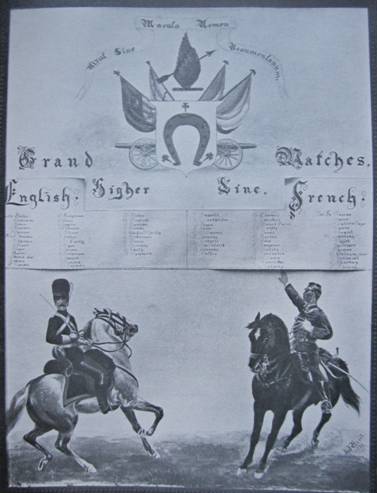
The Grand Matches were played at Shrovetide with the final on Shrove Tuesday. Not only boys played but the masters and any OB who was present. The first Match decided who would play as “The English” victors and “The French” losers. Before each match the English gathered to sing God save The Queen” at one end of the playroom gallery while the French sang the Marseillaise at the other. A cannon shot started the game which lasted 2hours with another shot at each half-hour. At the end the National flag of the victor flew with the loser’s at half-mast. The teams marched back to school to their national anthems with the vanquished first. The Last Match was played in 1892.
At Dinner Wine was served to Captains, Guarders (goalkeepers) and scorers. In later days wine was served to all but scorers had a glass per goal and a pancke per goal ( they were said to be of gargantuan size).
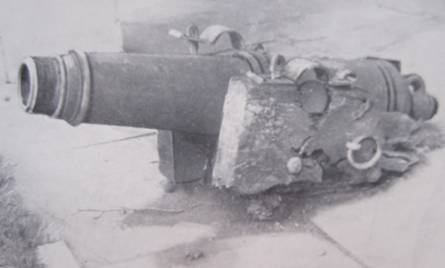
The cannon was presented in 1864 by Admiral Manners ( RN and astronomer: Crater on the Moon is named in his honour). Son Leo ’68 (RIP70). He also presented one to Stonyhurst which blew up in 1889 afterwhich the Beaumont gun was spiked. It then was placed outside the Second guestroom.
School journals, quite apart from being a wonderful historical record, were yet
another method of display utilized by schools in this period. The production of
journals to professional standards at the major public schools became standard
towards the end of the nineteenth century. The Beaumont Review did not surface until in 1894, and apologized in the first issue for its own tardiness. 'To some people,' the unfortunate editor conceded, it had seemed' anomalous that a school of the size of Beaumont should be without its paper." The Beaumont Review was published at the request of its old boys.
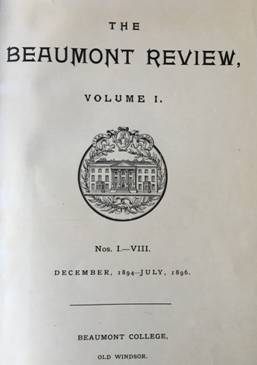
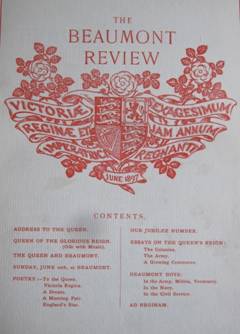
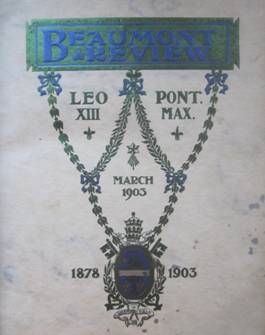
Some of the special Editions of the Review
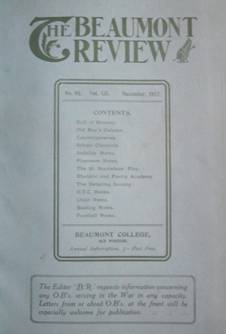
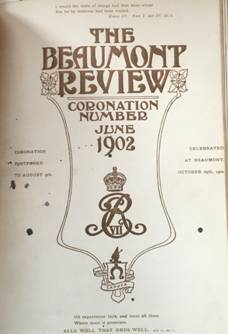
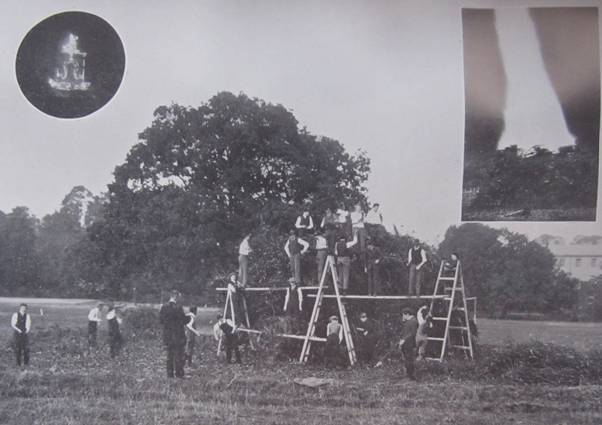
Preperation for the 1911 Fiftieth anniversay bonfire.
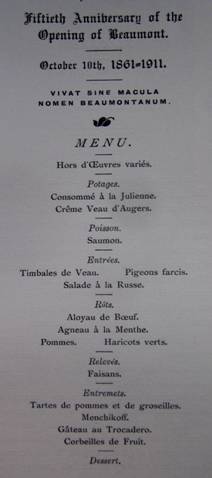
The menu for the 1911 Jubilee lunch given at the College for the Staff, Pupils, Old Boys and Parents.
The eight courses that included wild salmon, stuffed pigeons and pheasant also offered Menchikoff, the Beaumont pudding. For the gourmets the recipe is as follows;
Line 3 bowls with thick sponge cake, damping the side next to the basins with sherry. Pound finely 1 1/2 lbs of sweet almonds, mix them with 18oz of fine white sugar, the yolks of 3 beaten eggs, 3/4lb of fresh melted butter, 1 ½ glasses of whisky (large wine glass), 3 tablespoonfuls of vanilla. When all is well mixed, put into the bowls, cover the top with more sherry dampened sponge, put a plate on top of each with weights and leave overnight in a cool place, and serve with whipped cream.
To say it is very rich is probably an understatement and disastrous for those concerned about their cholesterol levels. Wine included Champagne supplied by Charles Heidseick (OB).
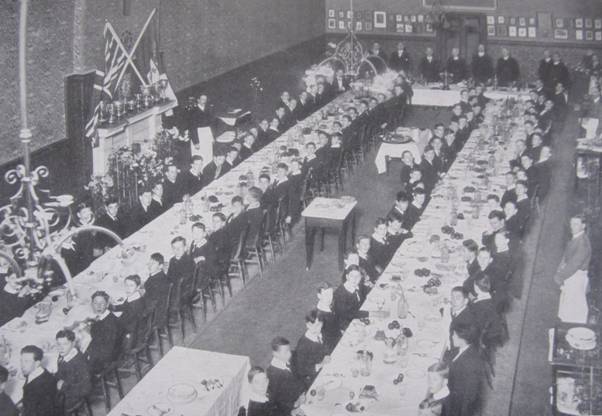
Dinner in honour of the Hon francis Russell on his elevation to the Bench in 1919. He was later the Rt Hon the 2nd Lord Russell of Killowen.
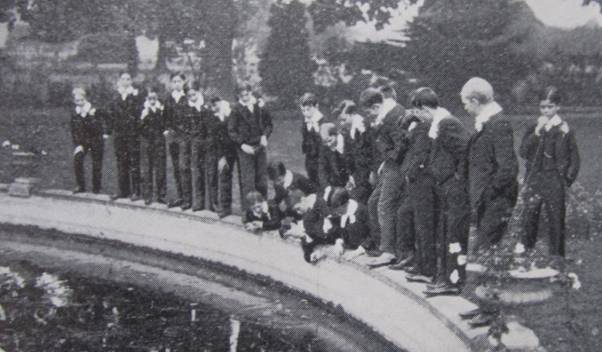
Lower Line boys around the pond on the back lawns

1931 Lourdes Pilgrimage
The School sent parties to Lourdes following the Great War and thse continued till the School closure.
Among the pilgrims shown:- P Emerson ( Lt Col Punjab Regt) W Hope-Nelson ( Lt Col 8th Hussars OBE, polo player 3rd Bart) D Garces (Trinity Camb & St Thomas’s)., C Davis ( WW2 RAF Flt Lt KIA N Africa 1942) , N Throckmoton (WW2 Major KOYLI), R DuVal ( Sydney Univ. WW2 Surg-Lt Narvik DSC) .
,A Throckmorton ( Montreal Univ. Priest, 12th Bart) , F Wolff ( Olympic Gold Medallist, WW2 Capt Ox & Bucks, Ch. Metal Exchange) ,J Drummond ( Sandhurst R. Ulster Rifles WW2 DSO Brigadier) , P C Leggetter ( Science Master, Commander OTC), J Talbot, ( WW1 Lt Coldsteam gds, 4th Baron of Malahide), G O’Connor ( Christs Camb. Middlsex Hosp. WW2 Capt. RAMC. Mayor Abingdon)
BOATING
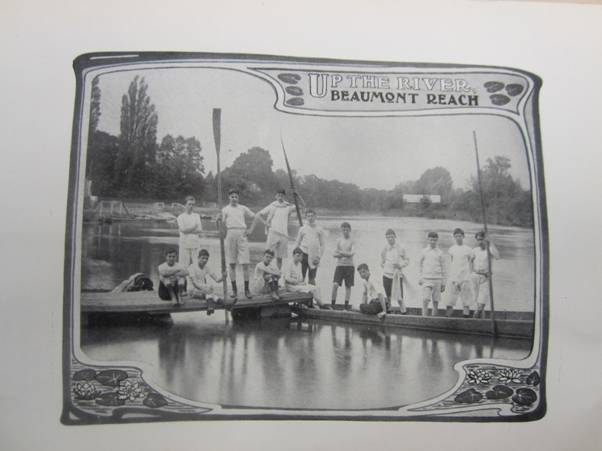
Although boating was the oldest of the school’s sports, The Boat Club did not formally come into existance till 1895 when an VIII took to the water for the first time. Th Crew:-
J Stevens, ( WW1,Capt. RFA, Rancher Mexico), A Maitland,( WW1 Capt. Ceylon Contingent.) E Conway (Boer War Lt R Munster Fus. Wdd, Dispatches, WW1KIA Gallipoli 1915), W von Boeselager (Capt.),( Freiherr, ran his estates in N.Rhine Westphalia) H Ryan , N Lyons, ( Engineer) J Stuart y Falco, (Duke of Alba, Spanish Foreign Minister, Ambassador, Olympic Siver Medallist), C Whitelaw (stroke) (Balliol WW1 Lt Devons) and G Langton (cox) (Sir George, High Court Judge, Chairman All England Club).
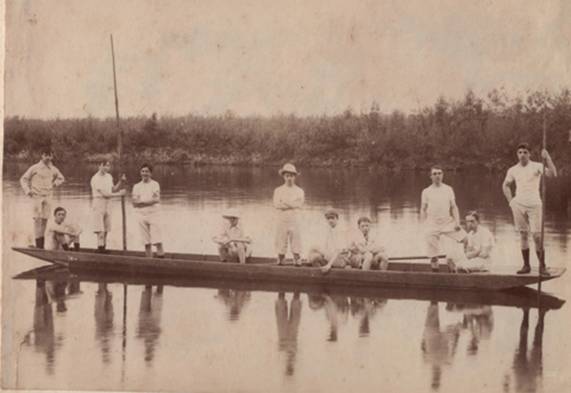
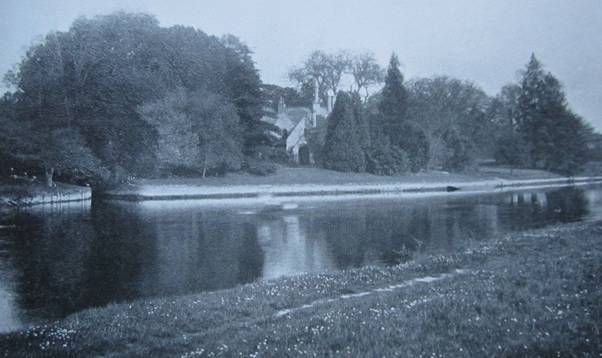
Part of the “Beaumont” Reach at Runnymede
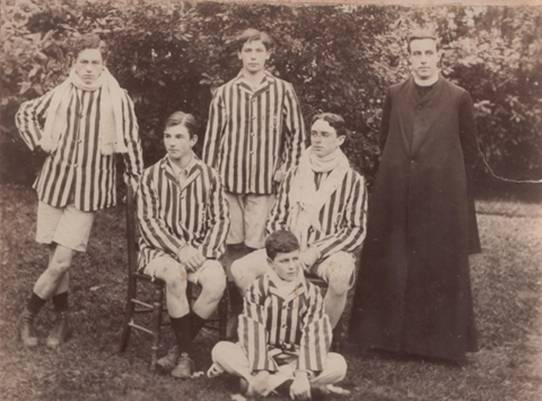
The first boating colours were green and white stripes
The *Maitland” Four with their trainer Fr Mayo. The crew was F Smith (Trinity Camb. WW1 Lt Dragoon Gds, m,d of Gen Sir Arthur Wynne) R Mayne (WW1 Capt ASC Order of White Eagle, Chief Constable East Suffolk), H Dalrymple ( Christ Church Ox. PC to HH the Pope, 9th Bart) A Maitland ( Motor designer, Mountain Climber) and G Grisewood (Cox) ( Capt. Grenadiers, Tfr as Adjutant to brother Herman OB Royal Sussex. DAS March 1916)
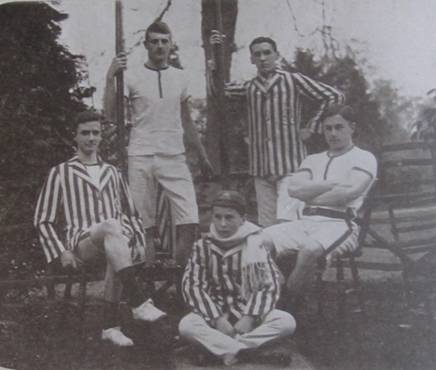
The Four of 1906
J Harter (Sandhurst, DLI WW1 DSO, MC wdd, KIA Ypres 1916), R Morison ( Balliol Ox. WW1 City of London Yeomanry), H Grattan-Bellew ( son and heir to Sir Henry OB died suddenly in Nov) R Raffo ( Sch. of Mines, Engineer Tunis) G Monk (cox) (Eton, Sandhurst Welch Regt, WW1 KIA Oct 1915).
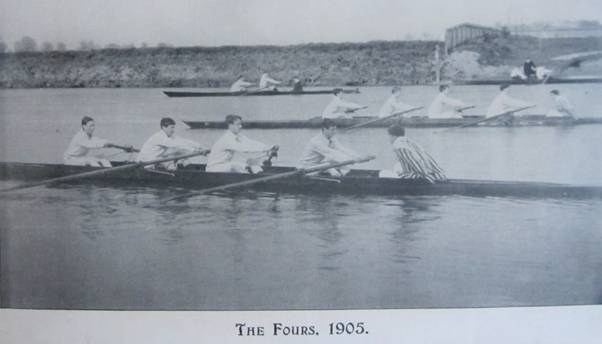
The race in April when the “Ryan” Four beat the “Maitland” .
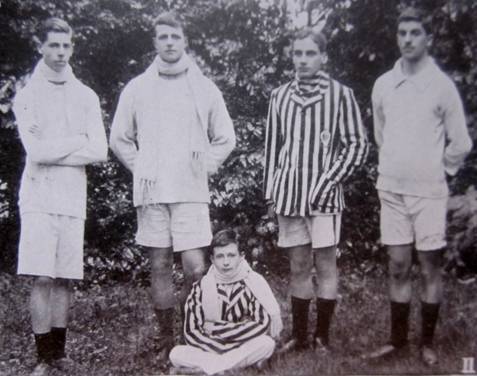
1908
De las Rivas ( Spain, Marques de Mudela). Wood (Merton Ox Law, WWi Lt Ox & Bucks KIA July 1915). McGrath ( Jamaica, WW1 Capt Lancs Fusiliers). Vetter (Magdalene Camb, Diplomat). Cox Hartigan ( WW1 Lt Northamptoshire Regt KIA Aug. 1916)
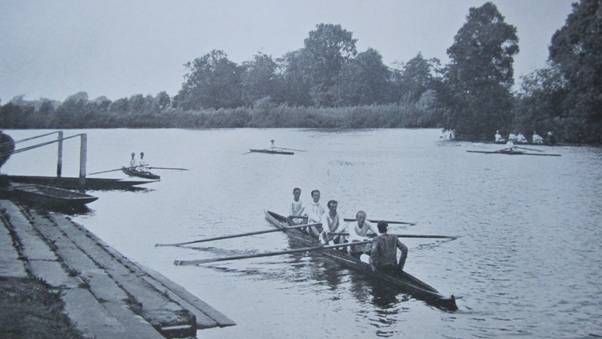
1911 leaving the Boathouse steps
In 1912 Beaumont won its first Regatta at Staines in June.
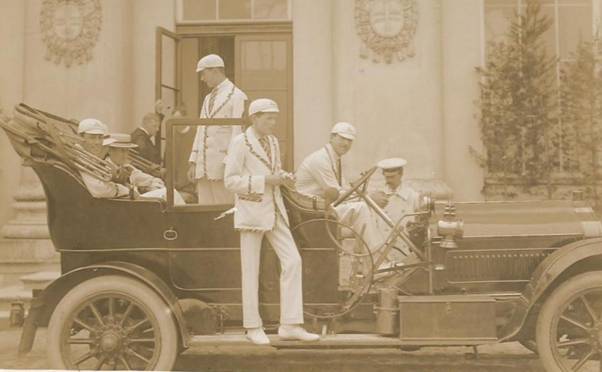
Beaumont first sent the VIII to Henley in 1913. The only other school entries were Eton, Radley, Shrewbury and Bedford. The lightest and youngest crew in The Ladies Plate, they rowd against Trinity Oxford stroked by the future Sir Arthur Quiller Couch and two stone heavier all down the boat. Beaumont led at Fawley but eventually lost by 3 lengths to the eventual runers-up. It was reported that “Beaumont did well for its first essay and we hope to see them again”.
The crew was international: Balfe (Natal S A), Russi (Morroco), WW1 Capt Innisking DG, MC. Eyre (Peru) WW1 Lt Irish Gds KIA. Mckay (Co Down Ireland), WW1 Major West Surreys MC & Bar. de Las Rivas ((Bilbao, Spain) Marquis de Mudela. Arnoso (Lisbon Portugal) diplomat Count d’Arnoso. Wynne (Philadelphia USA) WW1 Capt. US EF. Berrill (Sydney Australia) WW1 Lt Royal Fusiliers KIA, and Cox Parrott (San Mateo, USA).
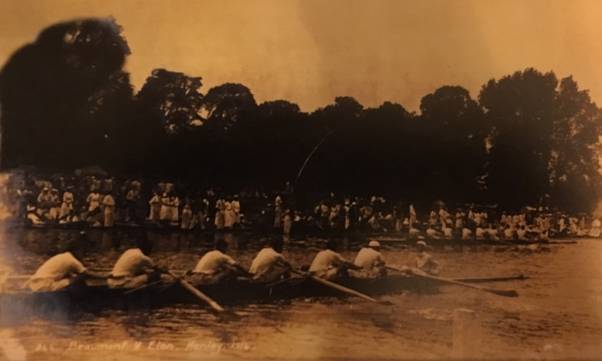
Henley: Beaumont V Eton 1914
Beaumont drew Eton in the Ladies Plate giving away a stone a man. They held them till coming up to the enclosures when Eton sprinted away to win by 2.5 lengths. The Crew were C Wynne (USA), F Parrott (USA, WW1 DAS), P Waters (WW1 Capt Scots Gds MC), F de Las Rivas, L de Las Rivas ( Spain), F Russi (Morroco) , R Castelli ( Lived New Yok), Cox R McDonnell (Canada, WW 2 Col. 9L. DSO & Bar KIA).
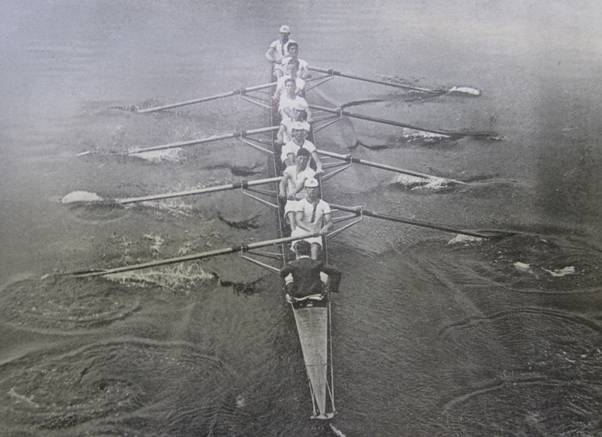 1921
1921
An VIII that beat several records on the Beaumont Reach, The crew included Terence O’Brien Olympic Silver Medallist (pairs) Commonweralth Gold (VIIIs.) . Stroked the winning crew for the Grand at Henley and Coached London RC to the Triple Crown. Also in the crew was Louis Bleriot son of the French aviator who made the first cross Channal flight.
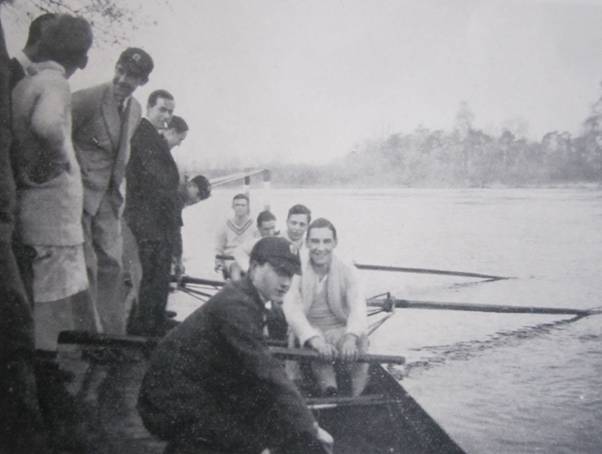
Happy faces as Boating starts in February
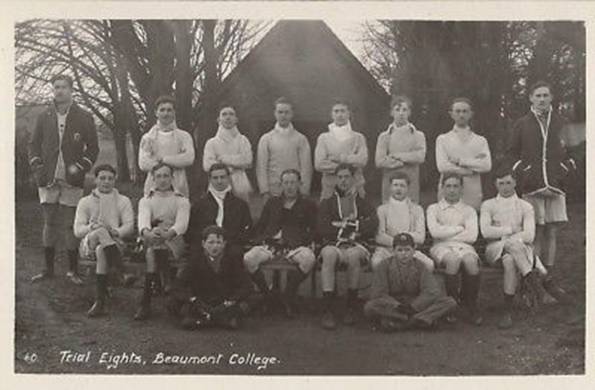
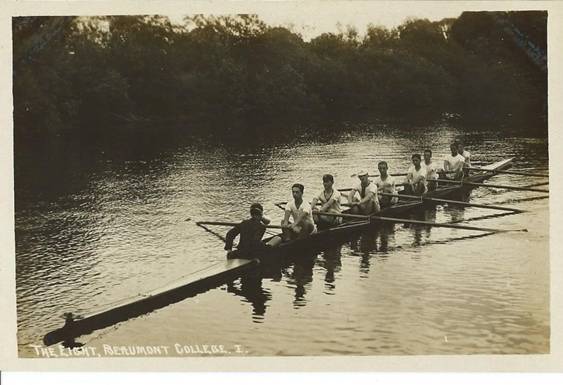

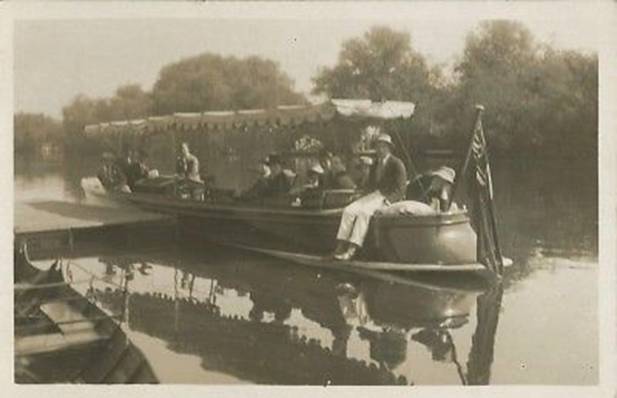
The Beaumont Chug-a -lug
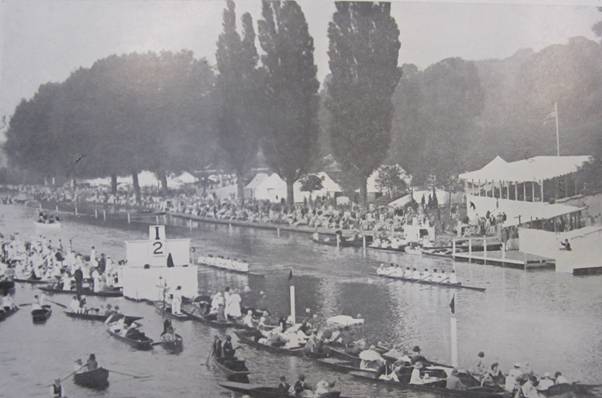
Henley 1925 Ladies Plate Beaumont beating Monkton Combe by a length. In the second heat they were beaten by Shrewsbury.
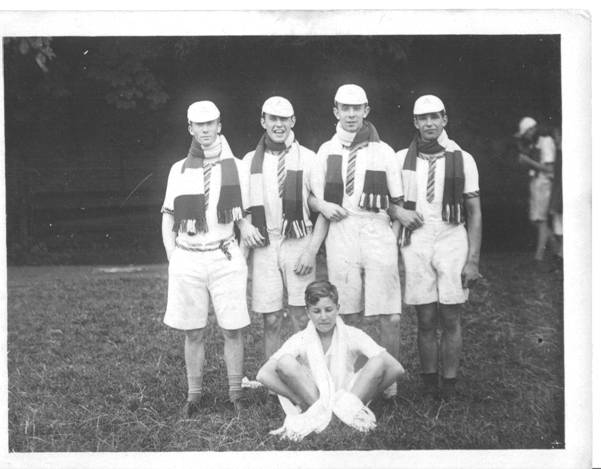
An all colours Four of the 1920s
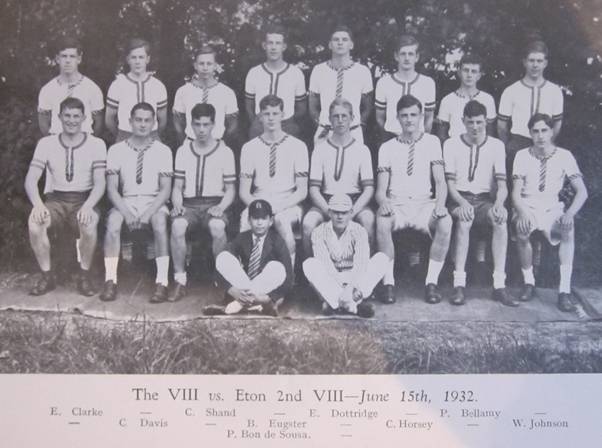
The Beaumont crew: Clarke (USA), Shand (Commodore RN WW2 DSC), Dotteridge ( WW2 Capt. Sherwood Foresters), Bellamy ( WW2 P/O KIA Nov 1941), Davis ( WW2 Flt/Lt RAF KIA Nov 1942).Eugster Irish Gds, WW2 DSO, MC & Bar Gen. Sir Basil) Horsey ( Benedictine Monk), Johnson ( Parish Priest), Bon de Sousa ( Portuguese diplomat)
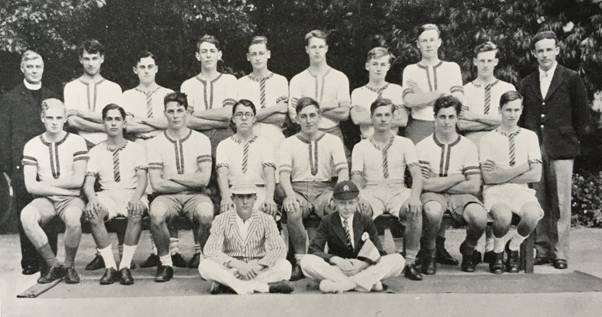
Beaumont and Eton VIIIs 1934
Back row, Fr Campbell. D O’Callaghan ( Barts, Psychiatrist), A Thackara ( USA). D Freeman ( UCD, Mater Misericordiae,Tropical medecine). D Bird ( Cranwell, Inter Services Athletics Chamion, F/O KIA Amiens May 1940).
Front, P Bon de Sousa (New Coll. Ox. Portuguese Diplomat). R Lacroze ( Argentinian, WW2 Major Highland LI ) J Farmer ( Athlete, Ballet Dancer WW2 SOE MC, MI6). P Poels ( St Thomas’s GP WW2 Surgeon RNVR)
Cox, A Dagnell Penley ( WW2 Lt-Cmdr RNVR then Canadian Navy).
CRICKET
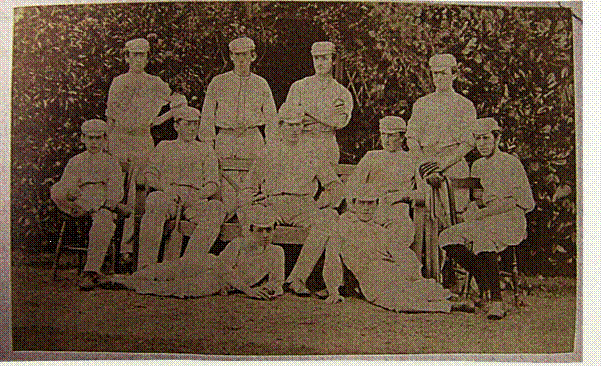
Beaumont Cricket XI – 1867
Left to Right; Back Row: James FitzGerald (married sister of OB Anthony Strong-Hussey), JE Butler-Bowdon (Col East Lancs m Monica d 12th Ld Petre, JP), Earle Stanley (died 1888), Joseph Stanley (died 1890) Seated: Francis Reid (Doctor died 1908), Augustus H Dillon (Son of Hon Gerald, m Baroness Adele de Poelnitz) Anthony Strong- Hussey (of Westown, Irish cricketer), Charles Roskell (Lawyer), Florian Rangell (from Hong Kong, Front: Isaac Carruthers (known as a fine athlete), Rowland Yallop.(lawyer)
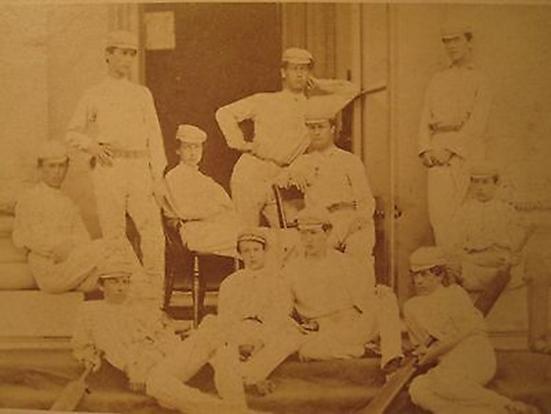
The 1869 side outside the White House. We have no record of who were the team members. Opposition came from The Baker Street Club organised by T l Molloy (Hon) the composer, Emeriti, the Rev Ld Petre whose brother Bernard (72) succeeded him, Windsor Home Park, Coopers Hill, Viscount Downe and the Life Guards and Lord Drumlanrig (brother of Ld James Douglas (64) and the Coldstream Guards. It was in 1869 that Beaumont beat the Oratory; this was the second time the two schools had met, the first had been in 1867 which was also a Beaumont victory. In those days masters and boys are recorded as cutting the pitch with scissors.
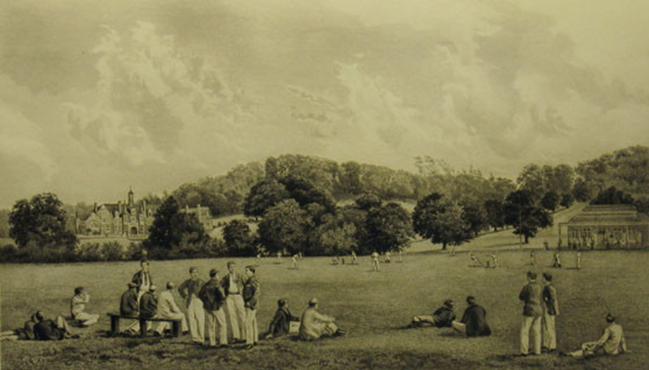
Cricket Ground 1892 by Francis Philip Barraud (1824 – 1900). One of a family of artists. He worked in both watercolour and stained glass. Best known for his paintings of colleges and cathedrals.
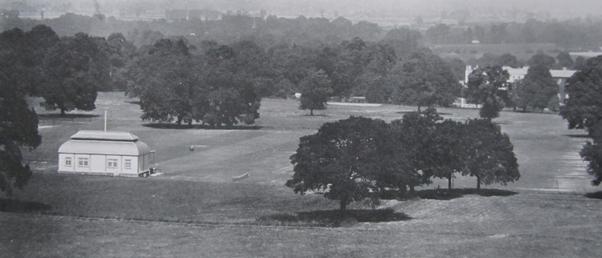
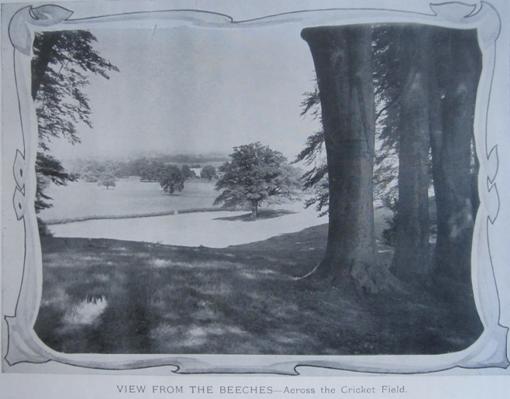
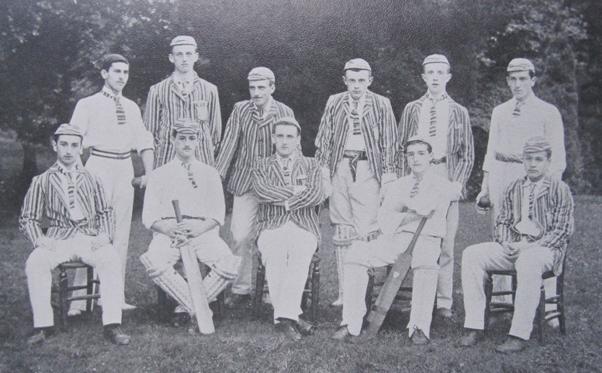
1889
A Darwood (Lawyer Rangoon) , F Woodlock (SJ, WW1 Chaplain MC ), J Murphy (Irish business Chairman), J Barrett ( Well known Horseman) , M Barrett ( International Financier, Boer War Brabant’s Horse) , R Hunter-Muskett ( Boer War with Lumsden’s Horse, WW1 Maj. Middlesex Regt.)
F Donelly ( Newfoundland), B Guzman ( S. of Venezualan President) , P Carton ( Irish Hockey player. Obstetrician/ Gynaecologist), J Gomar ( Spanish Engineer), C Green ( Colonial Service, Boer War S A Light Horse)
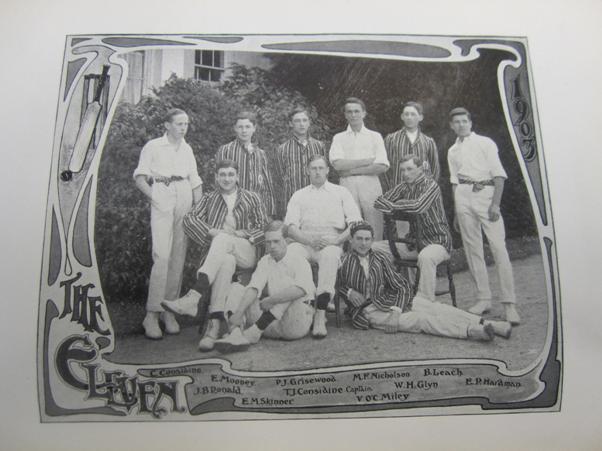
1903
C Considine (son of Sir Heffernan, Limerick, Farmer Rhodesia, WW1 Lt R Dublin Fus, KIA 1915)). E Mooney (Dublin, BNC Oxford,) P Grisewood (WW1, RNR DAS1916). M Nicholson ( Bombay, Barrister WW1 Lt Ghurka Rifles). B Leach ( Hong Kong, Slade School, English Potter CH CBE). E Hardman ( WW1 Capt RFC, DFC) . Seated J Ronald (Estate Agent) T Considine (Limerick, WW1 Capt R Dublin Fus, WDDx2). W Gl;yn ( S Africa, Barrister) Ground. E Skinner ( Son of General, India, RMAS, WW1 Maj. Napier;s Rifles WDD) V Miley ( Dublin, BNC Oxford, BLUE Football Tennis. Irish Tennis Champion 1920)
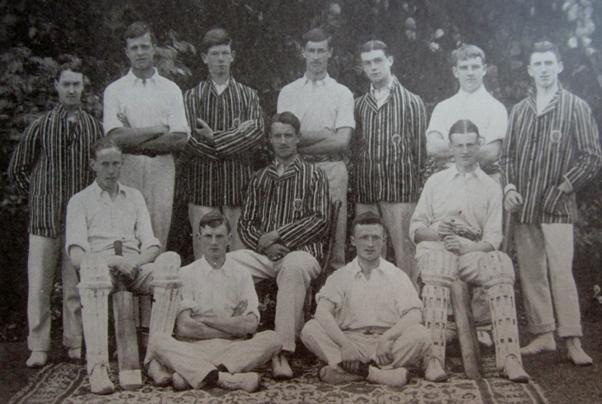
1906
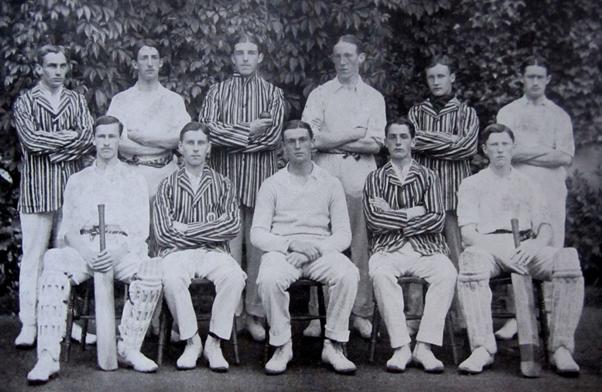
1908
A McGrath (Jamaica WW1 Capt Lancs Fusiliers). P Lambkin ( WW1 Capt Leinsters, wdd POW). W Thompson Drowned on a survey Exped 1911) . F Considine (ww1 Lt Munster Fuiliers wdd).T O’Brien ( S of Sir Tim. WW1 Capt. RFA KIA 1916). W Hinsley ( WW1 Lt Rrf wdd DAS Dec 1918)
E Mayne (WW1 Capt RFA wdd MC) . B Tolhurst ( Exeter Ox. WW1 Lt DOWs then RFC KIA April 1917). W Mooney ( BNC Ox. Irish Cricketer WW1 Capt Duke of Corwall’s LI wdd) . C O’Reilly (TCD Irish Hockey player, Capt RAMC DSO MC & Bar). J de Lisle ( WW1 Maj 17/21L, Cricket for Leicestershire, HS and DL)
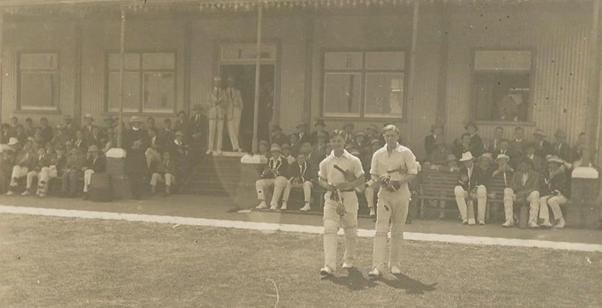
Opening Bats leave the Pavillion
FOOTBALL
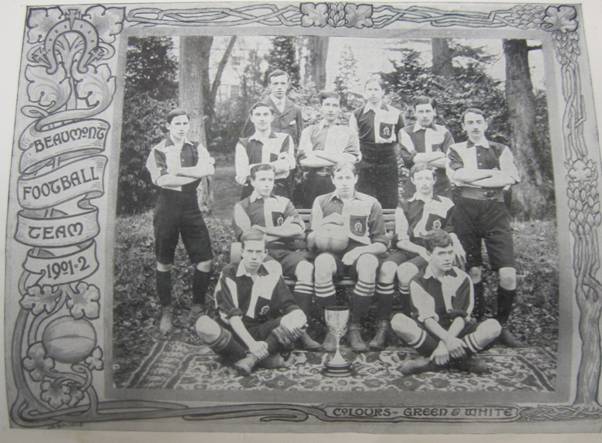
Association rules were adopted in 1896.The first colours (1890) for football were chocolate and Orange but thought to be too somber and later changed to Green and White
The side Beat the Royal Horse Gusrds, An Oxford Univ XI and Emereti, They drew with Mr freeland’s Xi and Eton.
Goal Marston ( Canadian, WW1 Canadian Mtd Rifles) , Backs Mr Mayo SJ , Gilbert Scott (Architect CBE WW1 Major RE MC ), Halves, Glyn ( Colonial Civil service SA) J Considine ( WW1 Capt. Dublin Fus. 2 wdd), Pearce ( School of Mines, WW1 Capt RE MC “blew the Peace Crater” KIA July 17 ). Forwatds St John ( WW1 Capt Northumberland Fus.) , Harrington (Co Cork) , H Considine ( WW1 Capt RIR MC MID KIA Oct !916) Skinner ( Sandhurst Napier’s Rifles I A, WW1 wdd), Egan ( Irish wine Merchant) .
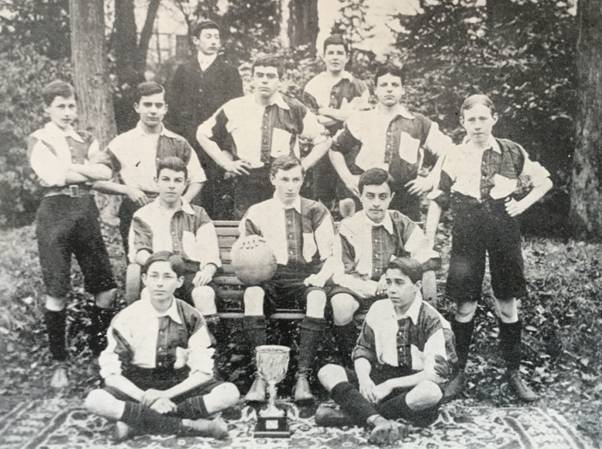
2nd Playroom team , colours white and Maroon
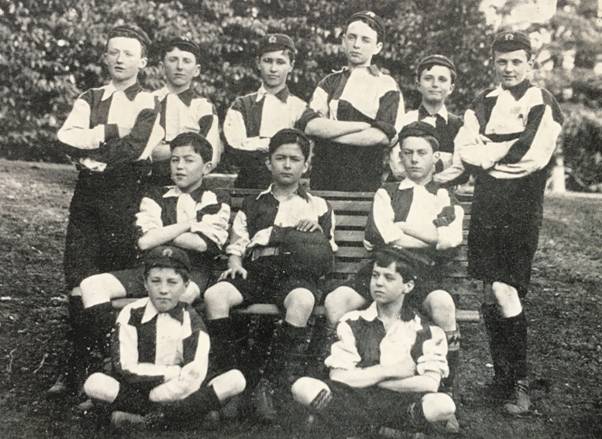
3rd Playroom side. Colours Dark and Light Blue
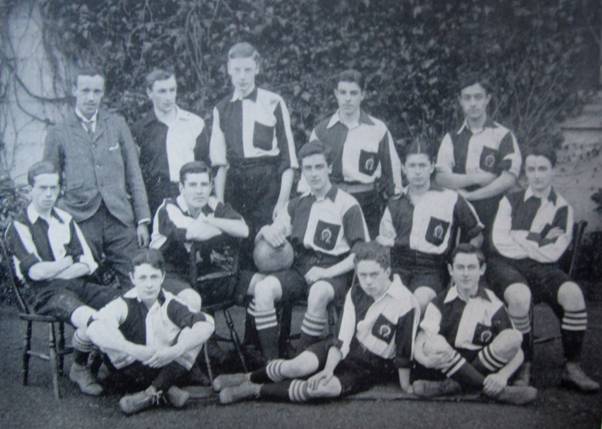
1903 - 4
Standing F Patmore ( WW1 Capt Hampshires, POW KUT MC War poet) . W Glyn ( Lawyer Natal) . P Mathews ( New Coll Ox. WW1 Lt Connaught Rangers wdd). H Freeland (To Brazil), S Hime ( New Coll Ox.)
E Skinner ( Sandhurst Napier’s Rifles IA WW1 wdd). E Hardman (To USA, WW1 Capt RFC DFC ). H O’Reilly (Whiskey distiller, WW1 RIR DSO MC Lt Col) . Eyre ( to Mallorca). Jackson (BNC Ox. Lawyer, WW1 Lt RFA. WW2 Dep. Gov Malta, War Crimes Board Nuremburg, Chief Justice Cyprus, KBE KCMG)
E Mooney ( BNC Ox. WW1 ASC) . G Skinner ( WW1 Maj. King’s Regt). V Miley. (BNC Ox. Football and Tennis Blues, Irish Tennis Champion 1920)
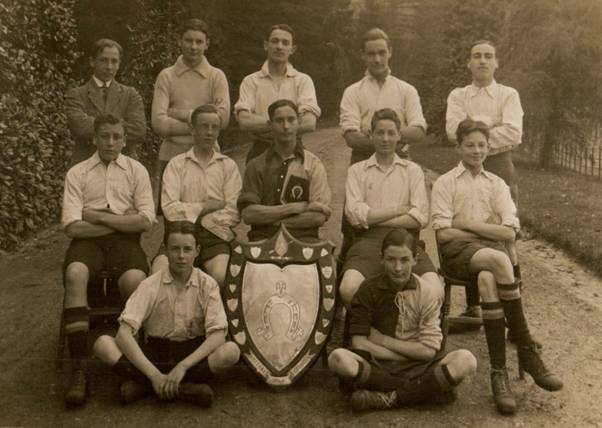
A Winning side in the Inter-House Competition
The shield bearing the arms of Kostka and sumounted by the crest with a scroll showing the motto on dark mahogany holds miniture silver shields with the names of past winners. It was presented by the then Mons.Thomas Dunn (87) later Bishop of Nottingham from 1916 -31. Co- donor was Bertram Smyth-Piggott (89) of Brockley Court, Somerset
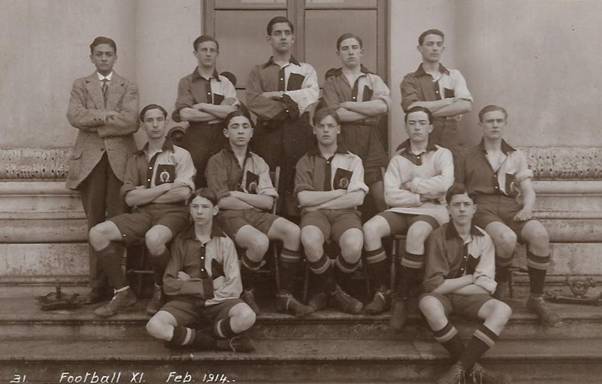
In 1906 the Footballteam changed its colours yet again to those of Cricket Light Blue, Dark Blue and Chocolate.
The Captain of the team was Lewis Clifford later Sir Lewis 5th Baronet SJ and the school Rector.
Others inthis group: H Maxwell (Capt Irish Gds WDD x 2 Lawyer). F de La Guardia ( Son of Costa Rican Ambassador, New York). D de Fayal ( 5th Duke of Palmella Portuguese Ambassador London GCVO). B Butterfield ( Capt Norfolks and IA Cricket for Derbyshire). R Cardena (Nicaragua to USA)l. A de Poer Power ( Lt Beds & Herts, MC). R Dauban Lt Col RFA). A Arnold (Capt RFA KIA 1918). V Rikh ( Rajah of Tajpore).E Gullet ( Brandy family, Cpl Fr Army Croix de Guerre, Medaille Militaire, KIA 1918). C Browne ( Lt Irish Guards).
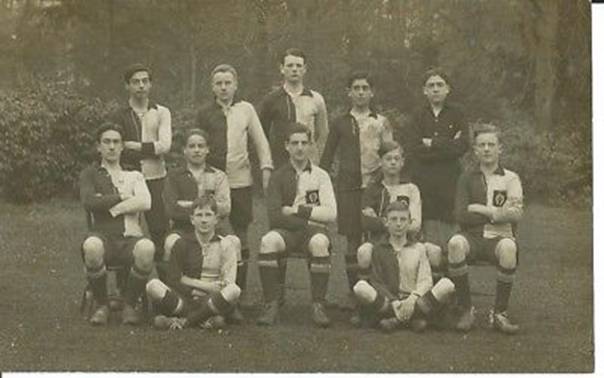
2nd XI 1916
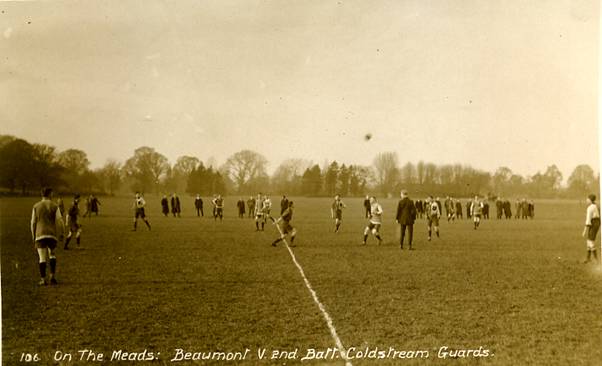
RUGBY
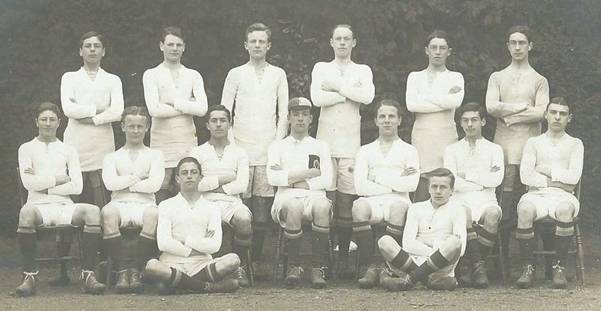
The First Beaumont Rugby XV 1917 playing in all white
Their first match was against The ISC (now amalgamated with Haileybury) which they lost as they did against Eton but they were the victors against the 13th Batt. London Regiment (Kensingtons).
The side included: Cochrane ( New Coll. Ox, Advocate General Sudan, WW2 Lt Col Int. Corps, SOE, DAS Aug 1946), Harraway ( S. Africa, WW2 SA Army Intelligence), Agar-Hutton ( Nyasalanmd, Killed during a lion hunt1929), (Robertson ( New Coll. Ox. WW2 Major Int. Corps MID), ( Waters ( Maths Exhib. Balliol Ox), Kirkham ( Sandhurst 6th Rajputana Rifles, Lt-Col). Roskell ( S of First Beaumont boy, farmer SA) de Vomecourt ( WW2 Founder of the French Resistance)
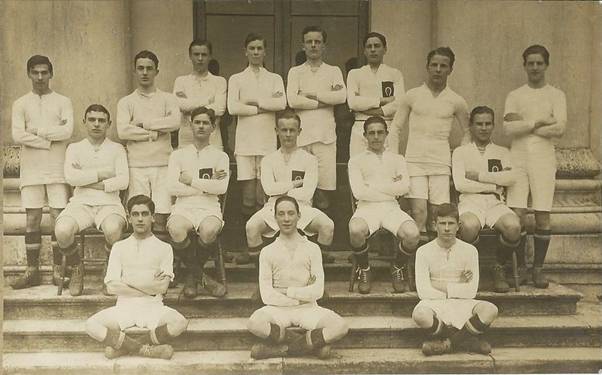
1918
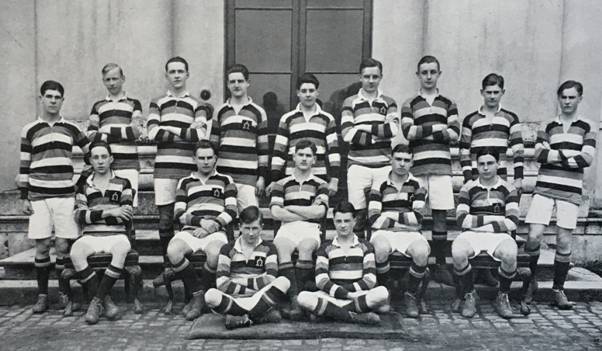
1920; the first side to play in the newly adopted Light Blue, Dark Blue and Chocolate colours taken from the Cricketers.
The side captained by Thomas More Eyston (Senior descendant of the Saint. H. Sheriff and DL for Berks. Capt. R. Berks. KIA May 1940)
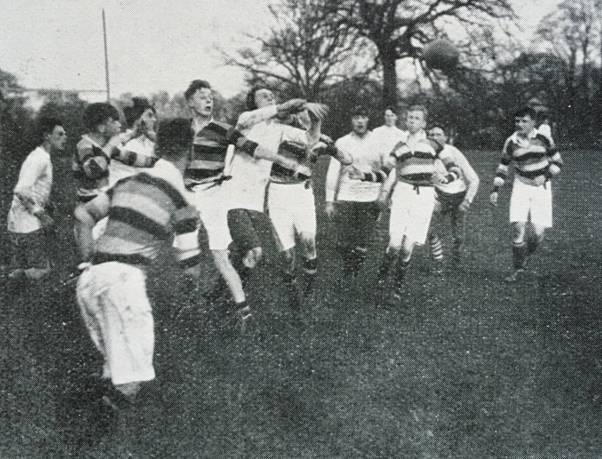
The Eton match 1920 won by 4 – 3
The Sportsman gave a detailed account of the Match which highlighted that Beaumont won by a Drop Goal in an interesting and very well contested game.
( Eton put their defeat down to the absence of F M Glyn who’s duties as Master of the Beagles had prior claim).
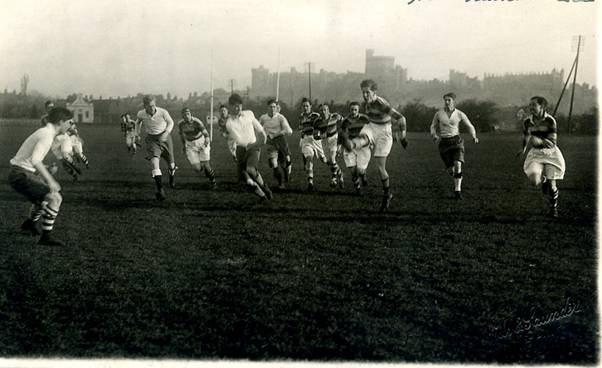
Another Eton match (away: Windsor Castle in the background)) in the Twenties.
BOXING
Although boxing had always been part of the Gymnasium curriculum it did not become a major sport in the School till the 1920s. Up until then there had been individual and then an inter house cometition. In 1913 George Pauling boxed and won at the Public Schools Boxing Competition at Aldershot. (Pauling :Sandhurst 17th Lancers tfr Grenadier Gds, Somme MC, Messines Wdd, KIA March 1918)
In 1922 the first team match was held against the Nautical College Pangbourne and with the introduction of the Army organised Four Handed Tournament in 1926 it was recognised with its own colours sytem. The Matches were held between Beaumont, Bradfield, Charterhouse and Wellington. Beaumont would be the only school to win on three successive occassions.
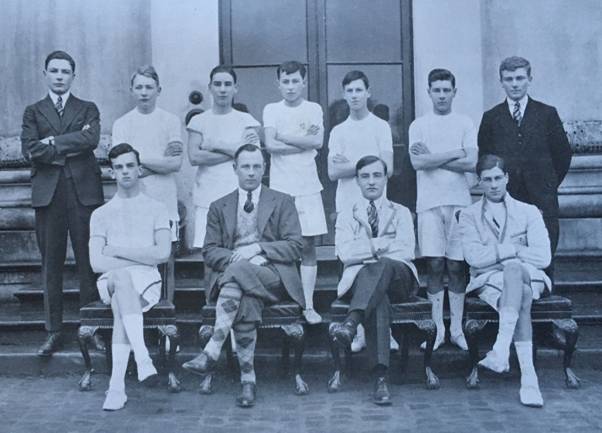
1926
The Colours Blazer was Light Blue with Dark Blue trimming
Lake (Solicitor), Outred ( GP WW2 Capt. RAMC), Hilterman ( Singapore, WW2 Jap POW Siam Railway Survived),de Las Casas ( Victoria Univ.Vancouver, Engineer) . Monro ( Army boxer, Lt Seaforth died 1932) , Bessell ( WW2 Capt. KAR. DC Uganda),Nolan (Emmanuel Cambridge Box Blue, Army boxer, Lt RE. Killed in avalanche Kashmir 1936) .
Russell ( WW2 Worcester Yeo,Ld Justice of Appeal 3rd Ld. Russell of Killowen), J H Thompson Esq. Gaetjens (Stock Broker WW2 Air Warden KIA rescuing personel from the BBC Oct 1940), Sweetman ( Sandhurst Lt Col N. Staffs. Wdd, Farmer Rhodesia)
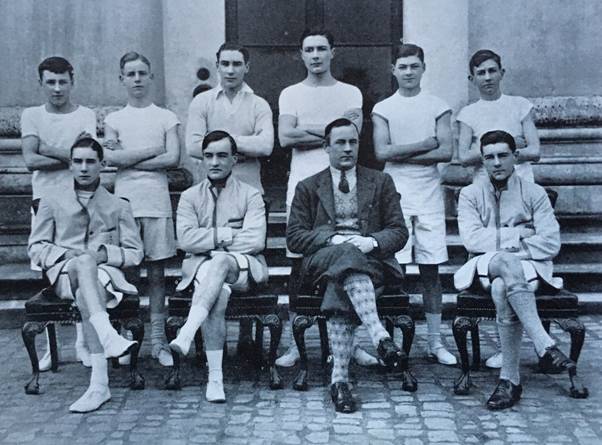
1927
OTHER SPORT
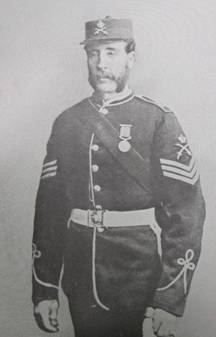

Sgt Thornber Gymnastic Instructor.
He enlisted in the Coldstream Guards 1858, and became a Staff instructor in Gymnastics and Fencing in 1870. He was employed at Beaumont in 1872 whilst still in the army coming over twice a week. In 1880 he became full time living in the lodge at the front gate. He oversaw the building and equiping of the Gymnasium at the school and throughout his service not a single boy received serious injury. He retired in 1907

The Gymnasium

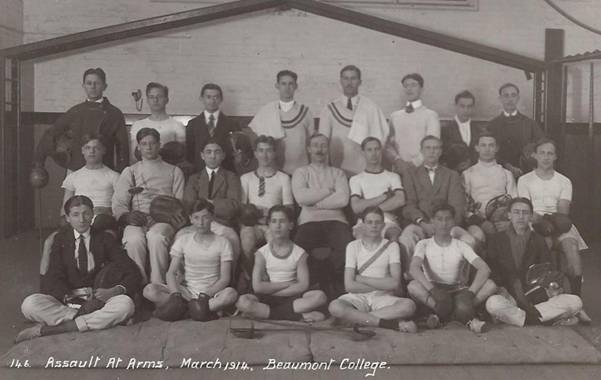
Fencing was especially popular up until the end of WW1 when boxing predominated
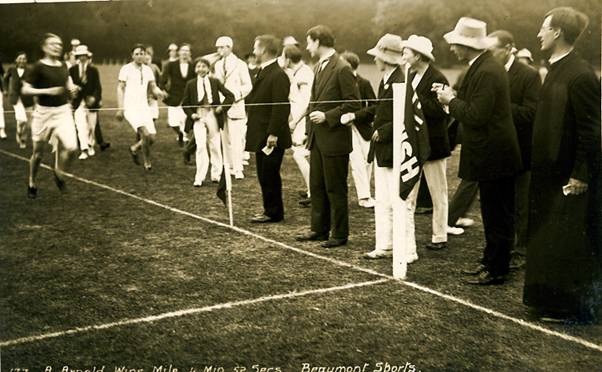
Athletics started in 1865 when James Molloy (the composer) on behalf of the Baker Street Club offered two prizes and the Sports became an annual event. Other trophies were presented by the Duke of Santona and Sir Taton Sykes. Perhaps the most unsual prize for the Mile Handicap in 1865 was “a pup of Juno,” Juno a fine back Newfoundland was one of the College pets and mascot. The Athletic tracks were laid out on the Cricket grounds close to the Pavilion.
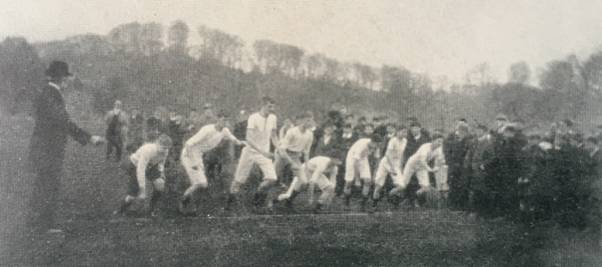
Start of the Mile
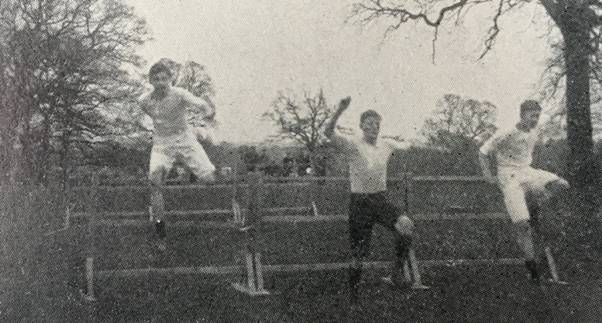
Final Hurdle

The school had the advantage and priveledge of using the Windsor Great Park for cross country running at a time when it was still the private domain of the Royal family.
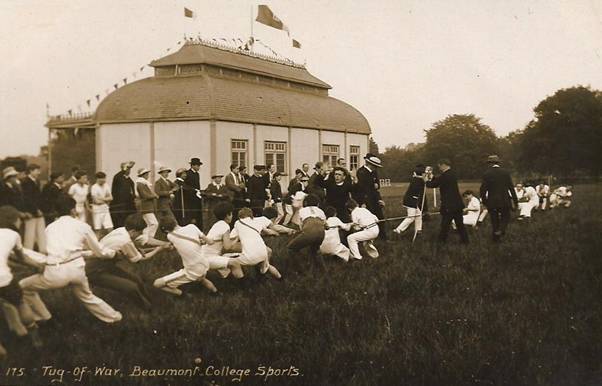
Inter-House Tug-of-war
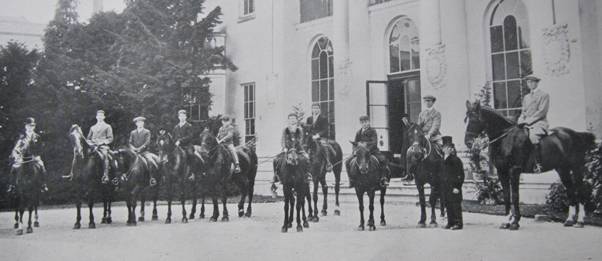
A Riding Class in front of the White House
According to the Bystander January 1910: “There is one feature of athletic training at Beaumont that is almost unique. The boys are taught not only to shoot but to ride. The training, moreover, is not confined to riding and jumping. The boys are also instructed in the points of the horse, shown how to juge its age and even how to shoe and harness”. A Gymkhana was held on Runneymede.
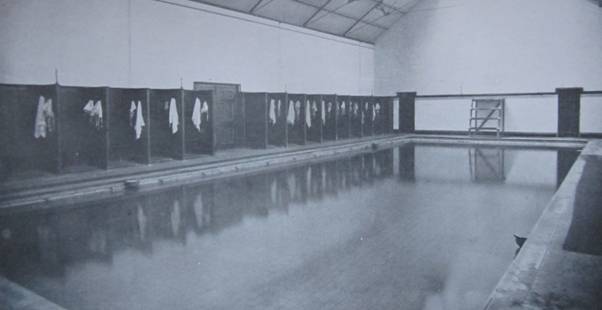
The covered swimming pool was completed in 1881, the first in the country. Charles O’Leary won for himself the distinction of being the first to enter the water plunging in fully-dressed. O’Leary was Commissioned into the RA and died on active service in Kashmire at the age of 27 in 1892.
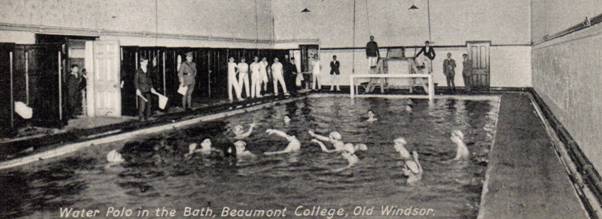
Water polo matches were sometimes played when cricket was rained off. Two recorded matches were against Eton in 1908 and against Old Amplefordians in 1911. On both occasions the home team was victorious.
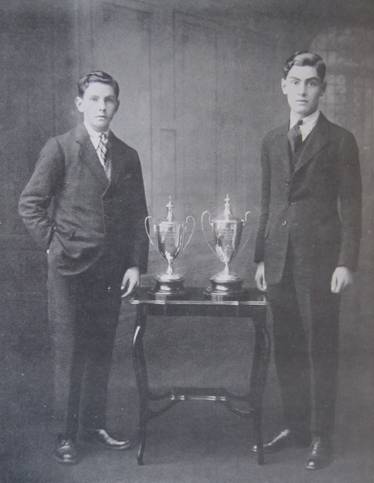
Public Schools’ Tennis Tournament; Winners of the Open Doubles Challenge Cup for 1919 and 1920.
Joseph Riba and Noel Mahoney
Riba and came to the school from Mexico and was an all-round sportsman playing in both the 1st XI and XV. Mahoney, the son of the owner of the reknowned Blarney Wollen Mills, also played in the 1st XI but is best remembered as an amateur jockey up until WW2.
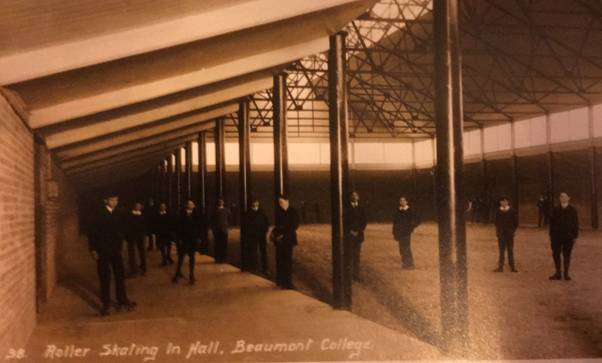
The Ambulacrum provided an ideal space fopr such activities as roller skating. Ice skating in the winter was also popular on the large ponds in the Great Park.
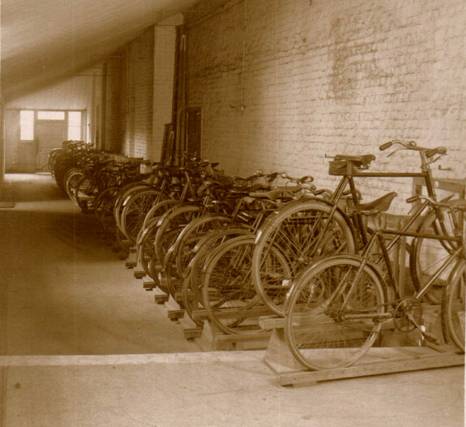
The Bicycle Gallery between the swimming pool and the bath house.
THE CADET CORPS
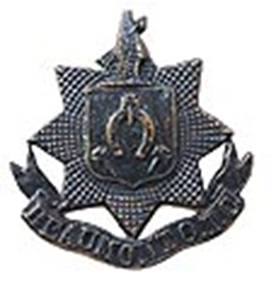
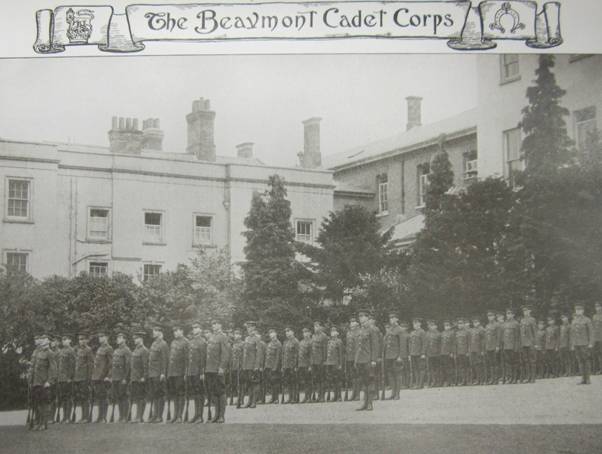
The Corps ( fifty strong) was formed in 1906 and application made for affiliation to the Royal Berkshire Regiment. However they already had two other school Corps: Wellington and Bradfield. While the matter was being discussed the Corps decided to “go it alone” and ordered their own pattern of uniform (Rifle Regiment) and purchesed sufficient rifles to equip themselves: The Officers swords were presented by the Rector. Eventually through the auspicies of FM Lord Roberts the C in C the Corps found affiliation to the East Surrey Regiment. The first Officer invited to inspect was Colonel Sir John Ottley. In the autumn a junior Corps was formed but wearing brass buttons and the glengarry.
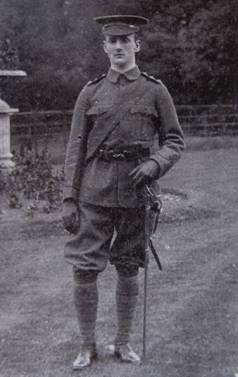
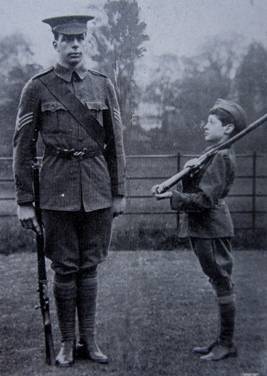
Captain of The Corps 1908: B Watkins Sgt A Dignan Junior Cadet E Copner
Watkins was Australian and became a solicitor in Sidney. Dignan was from New Zealand, WW1 Lt Canterbry Regt NZEF, WDD, Lawyer. Copner, Lincoln Oxford, WW1 Lt Devonshires then RFC.
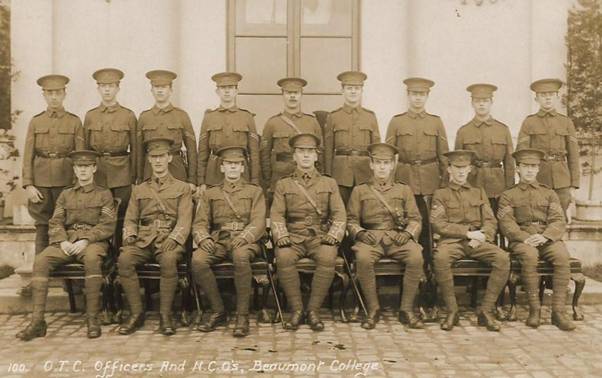
The Cadet Officers and NCOs
In 1907 a miniture rifle range had been built and an armoury and orderley room completed
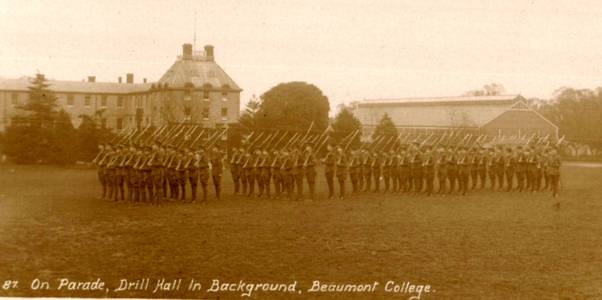
Drill practice
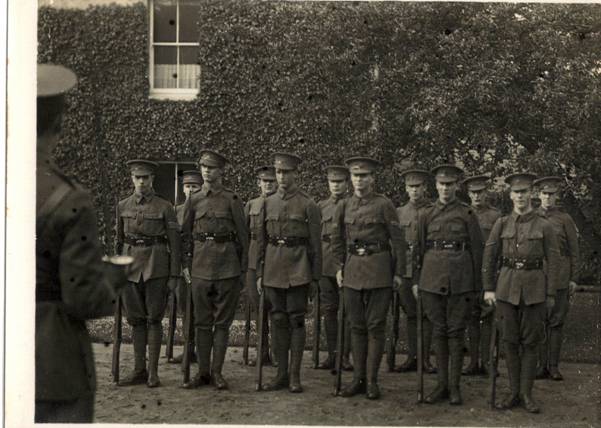
Awaiting Inspection
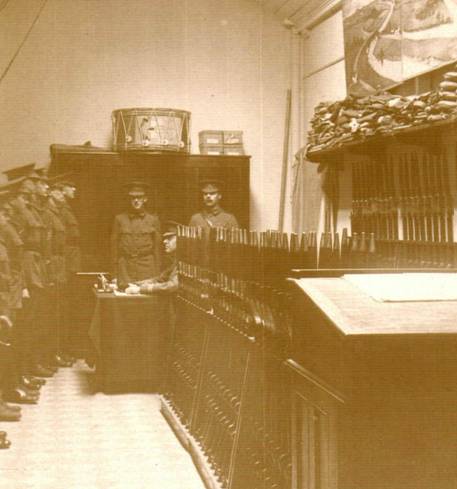
The Armoury
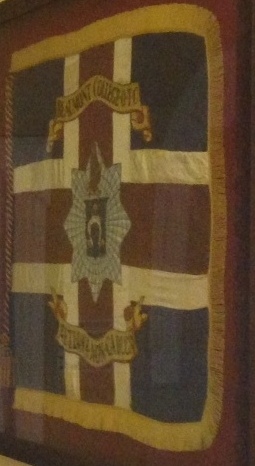

The Colours and Sergeant –Major J Bridcutt Coldstream Guards
the first instructor of the Corps
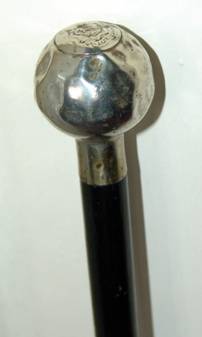
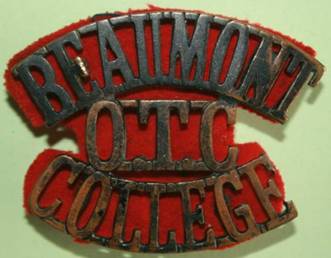
Officers Swagger cane; Black malacca with silver crested knob. Shoulder title
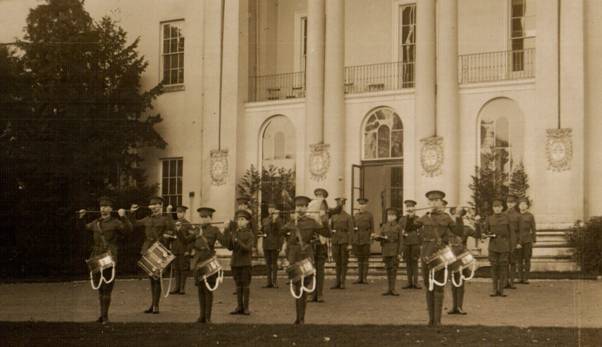
The Corps of Drums
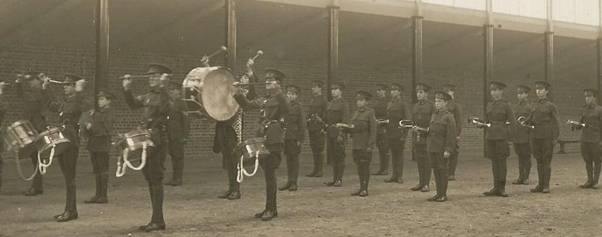
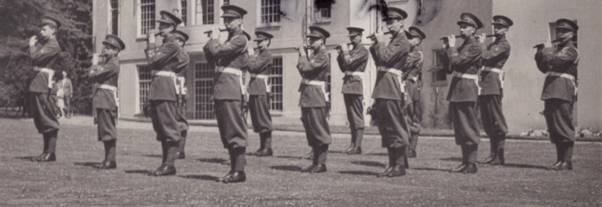
Post WW1: The Fife Section
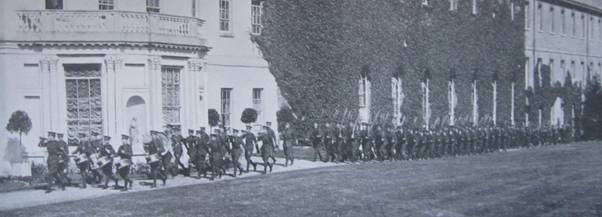
Marching to parade

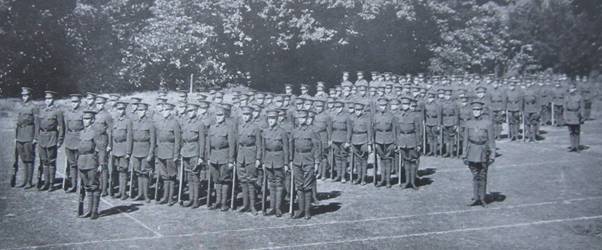
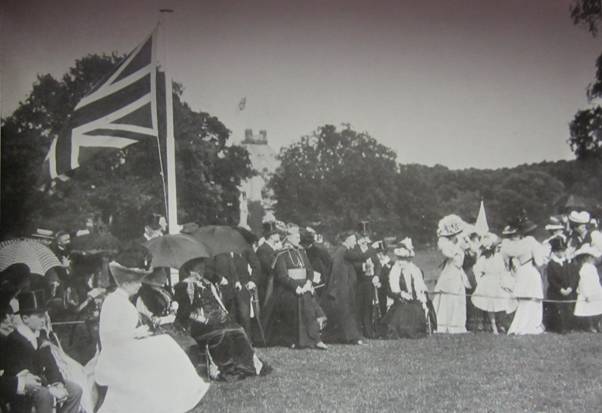
Spectators for the first Trooping in 1907


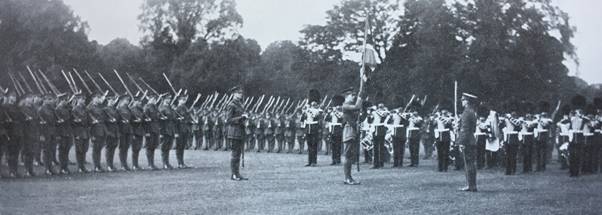
1923 The Ensign receives the Colour

Trooping 1932
Rear Admiral Gerald Dickens (later Admiral Sir Gerald KCVO CMG CB) OB 93 taking the salute. Band of the 2nd Bn. Scots Guards and the Beaumont Corps of Drums
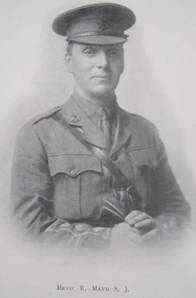
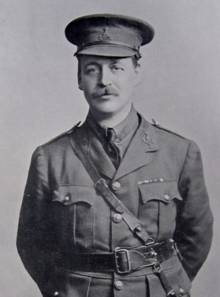
Captain Edward Mayo Lt Colonel Sir Mark Sykes Bart
The son of a VC, Fr Mayo SJ commanded the Corps from 1906 to 1926. Following the severe reprimand to the Cadets by a General for calling the CO “Father” he was always addressed as Captain. Sir Mark Sykes (OB) who commanded the Corps in Camp on a couple of occassions before WW1.
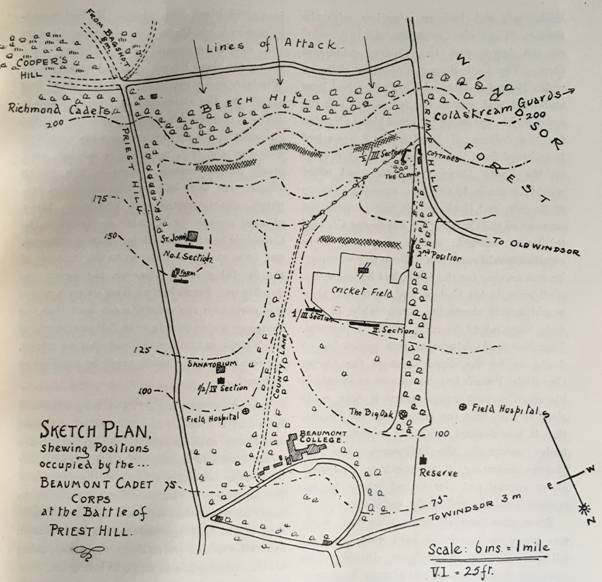
Tactical Map of the first manoeuvres by the Corps in 1907 with the defensive positions below The Beeches.
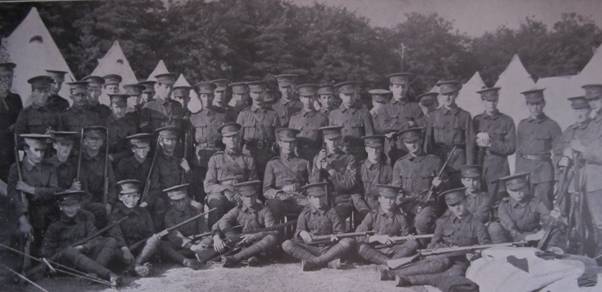
Camp at Tidworth 1910
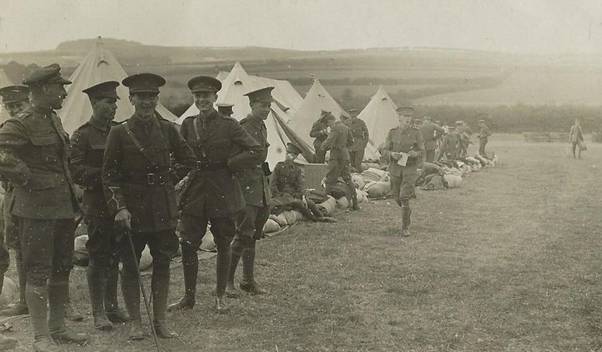
The annual camp was organised in conjunction with other OTCs. The Beaumont contingent usually contributed to a Battalion formed from schools such as Eton, Wellington, Bradfield, Radley and The ISC
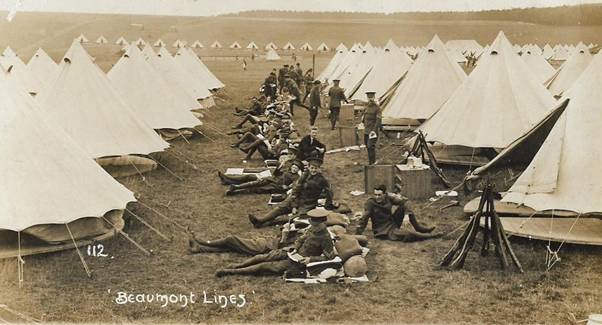
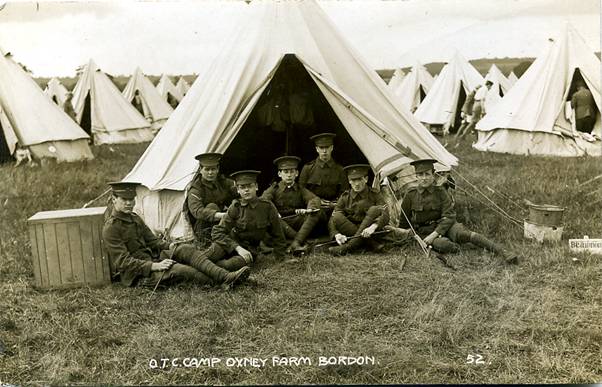
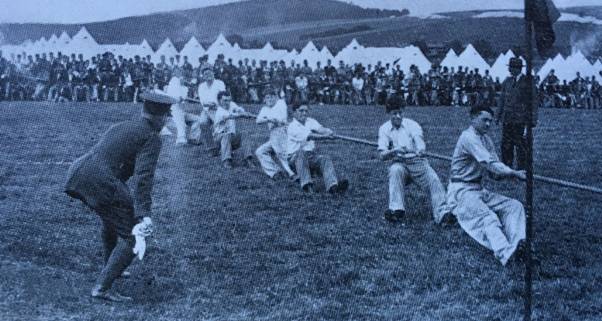
1932 Beaumont OTC Tug of War Team
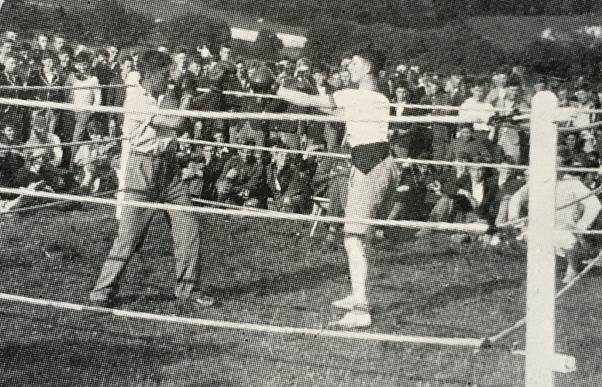
1932 OTC Camp inter-School Boxing: Beaumont won 6 of its 7 bouts.
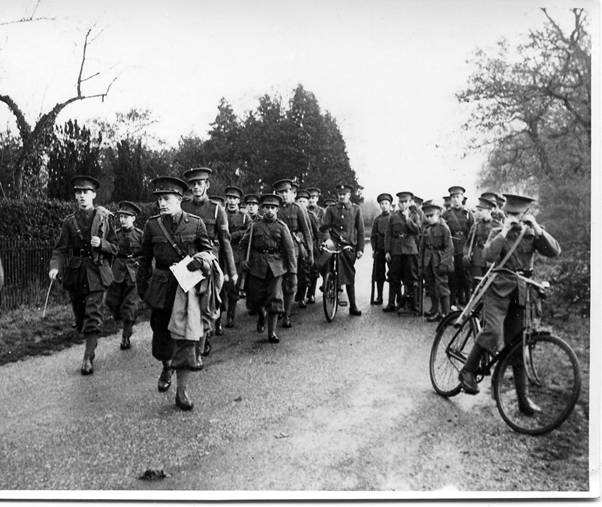
Post WW1: Training near Pirbright with the Guards Depot
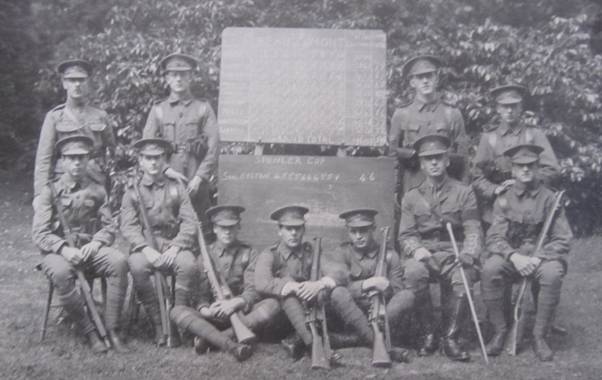
The Bisley VIII 1920
S-M Martin, Sgt Burgess (Trinity Camb. Barrister Clerk of The Peace County of London), Cpl Tunnicliffe ( St Thomas’s MD) Pte Cooke ( WW2 Major RE)
Cpl Waters (Balliol Ox). Sgt Eyston ( Descendant St Thomas More, New Coll Ox HS Berkshire WW2 Capt. Royal Berks KIA May 1940) Capt.Mayo, Cpl Harrington ( Shell Oil) Pte Liddell (WW2 F/O RAF), Pte Perez, Pte Waterkeyn (Paris).
In 1914 The VIII had its first success when placed 2nd in The Country Life Public school Competition. They competed at Bisley for the first time in 1920.
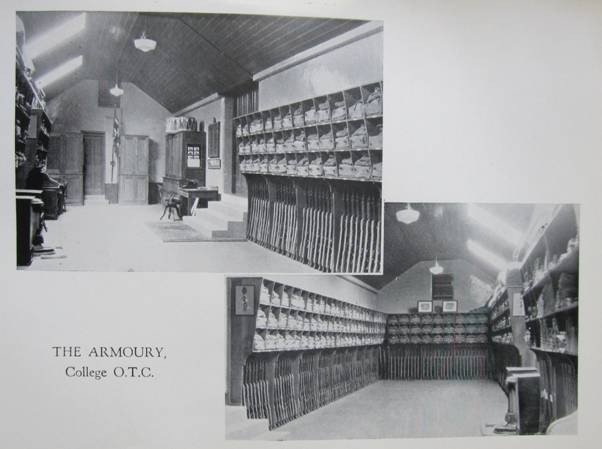
The New Armoury which was attached to the Ambulacrum
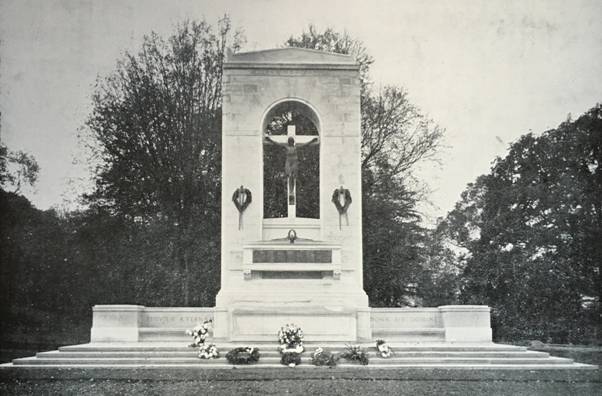
The War Memorial
Itoccupies a site in the midst of the College lawns dotted with large trees with a background of woods originally part of Windsor Forest. It takes the form of a large Greek Cenotaph embodying a Calvary with a life size figure, and a large Sarcophagus at the foot of the cross, on which are inscribed the names of the fallen, surmounted by a cast bronze wreath and crossed swords. A massive stone altar is incorporated for Memorial services, and wing walls with stone seats and a paved platform extend some 50ft in length. The total height is 33ft and the stone cross with bronze figure is set in an arch through which the background of trees can be seen. The whole memorial is constructed of the finest white Portland stone.
The Memorial was designed by Sir Giles Gilbert Scott OM ARA and his brother Adrian MC CBE both OBs. The Crucifix was modelled by Frances Burlison. Messrs Benfield & Loxley of Oxford were the contractors The Figure was cast by The Bromsgrove Guild of Bromsgrove, Worcester (who were responsible for the Crucifix in Westminster Cathedral).
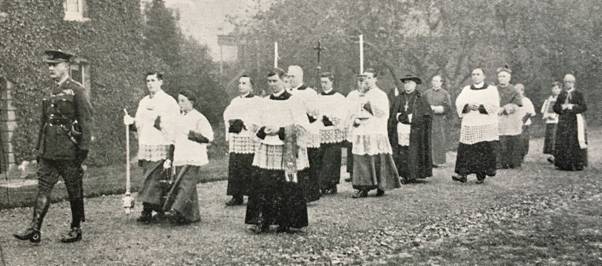
13th November 1921 The Feast of St Stanislaus.
Part of the procession with the Adjutant General Lt-General Sir George MacDonogh KCB KCMG. (OB). At the back are The Cardinal Archbishop of Westminster, their lordship the Bishops of Portsmouth and Nottingham.
The Procession was led by the Pipes & Drums of the Irish Guards followed by the College OTC.

The Blessing of the Memorial by Cardinal Bourne
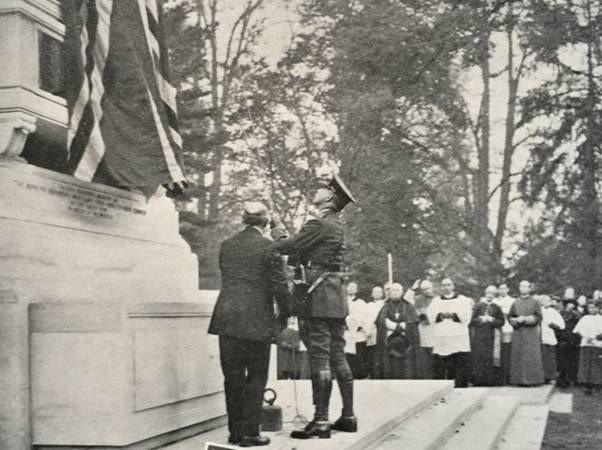
The Unveiling by the Adjutant General
Fr Francis Devas SJ DSO, OBE (OB) wrote:
“Read each dear name upon this stone
And having read
Remember why their blood was shed:
Through Honour was their strong faith shown
Whose faith, whose honour, are our own”.
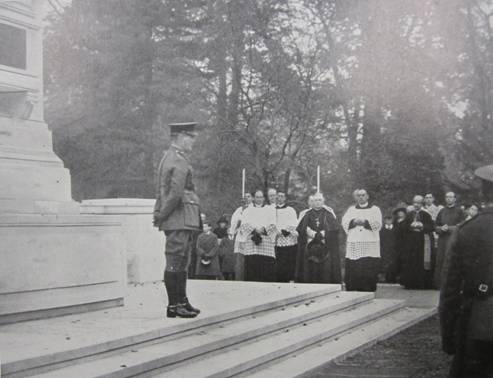
Sir George MacDonogh making his address.
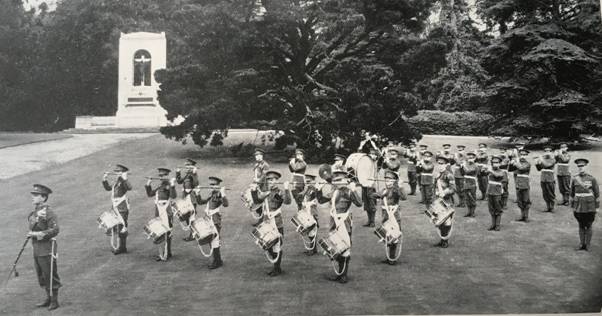
The Corps of Drums 1936
The Cadet Drum Major was DM Halfdan Leadlay (New Coll. Ox WW2 Capt. Green Howards). Band instructor DM Smith late Irish Guards. The Drum Major’s Uniform carried Light Blue, Dark Blue and Chocolate facings. A New mace was purchased this year and the sword was the gift of JP Sloan Emerson (Lt- Col Indian Grenadiers then Punjab Regt) and O Foster McInerney (Camb Univ, Capt. Irish Guards). The Base Drummer was Desmond Murphy (Hertford Ox. Major 3rd Carabiniers. MC).
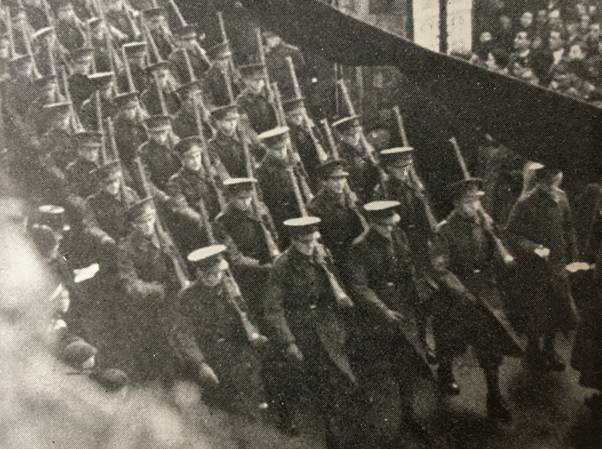
The OTC provided a Guard of Honour for the Proclamation of King Edward VIII in Windsor and formed part of the Street Lining Troops for King George V’s funeral procession.
THE BEAUMONT UNION
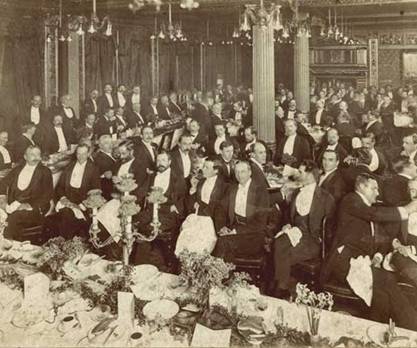
BU Dinner at the Café Royal 1901: Chairman The Hon Arthur Russell (Oriel Ox. Barrister, County Judge).
The Café was owned and founded by the Nicols–Pigache Family and the son and future Managing Director Daniel left Beaumont in 1900.

1910 Dinner at the Mansion house as guests of
The Lord Mayor Sir John Knill Bart (OB)
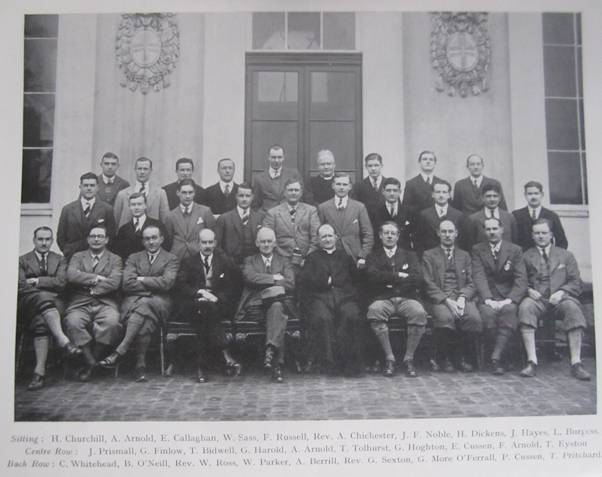
BU Gathering 1926
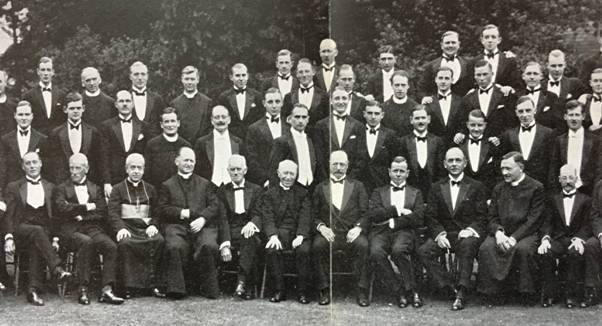
Part of the 150 OBs who attended the B U Golden Jubilee Dinner 1876 - 1926 at Beaumont
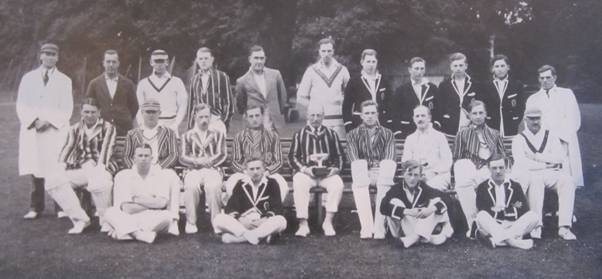
Charles Edmund de Trafford (OB), legendry cricketer brought am MCC side to play his old School each season. Apart from “CE” other OB players in this photo included Capt G Clifford (Sandhurst 8th Hussars WW2 KIA May 1940), Col. P Meldon (TCD RFA, DS0 Irish Cricketer).
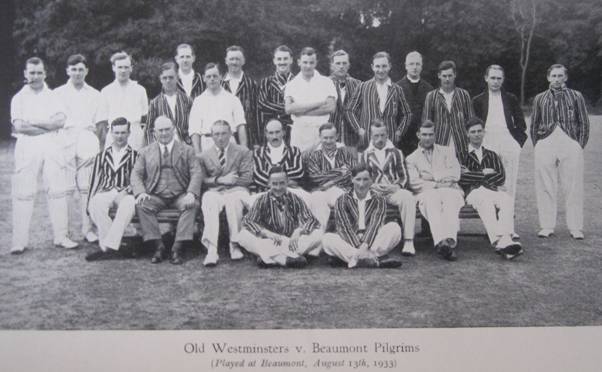
The annual match against Old Westminsters
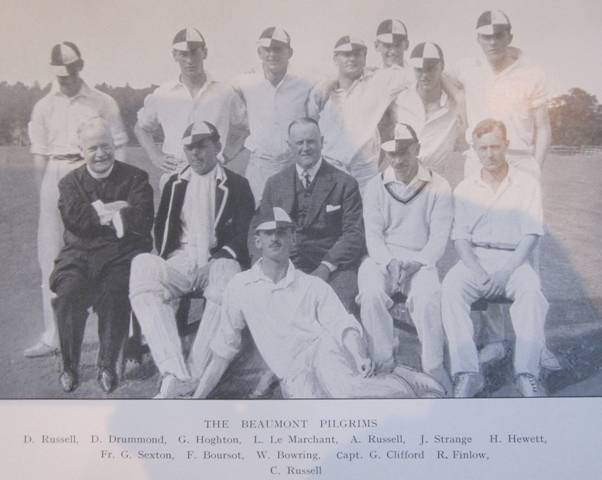
The Pilgrims would not only play other Old Boy Societies but would go on tour each summer.
Among those in this photo Dennis Russell played cricket for Middlesex, WW2 MBE. David Drummond WW2 Major Irish Guards,WDD, POW and survived a “death March”. George Hoghton WW2 Capt Norfolks POW 1940. Lewis Le Marchant Lt Col Ghurkas. Alan Russell Lt Col. London Scottish. John Strange Capt. Royal Sussex and Provost Marshal. Harry Hewett Capt. RA. Felix Boursot, of Perrier Jouet, WW2 Major RM. William Bowring Cricket writer. George Clifford 8th Hussars WW2 KIA. Gerald Finlow Major KSLI. Hon Charles Russell later Ld. Russell of Killowen.
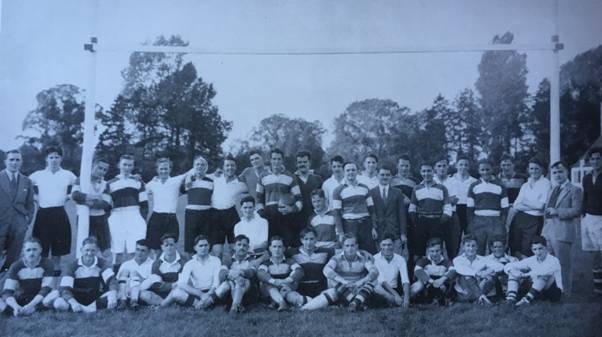
The OBs Rugby Club on Runnymede 1934
Captain H Seward (yachtsman WW2 Lt RN) , Hon Sec J Jenkins ( WW2 Capt Welsh Guards), others included J Wolff ( Ch. London Metal Exchange, WW2 SOE MBE) , E Dottridge ( WW2 Capt. Sherwood Foresters, MID), F Swann ( GP), S Darwood (WW2 RAF Flt-Lt KIA May 1940) , M Eisdell, ( WW2 Australian Inf Wdd ABC Broadcaster) A Burden ( Actor Hugh Burden), W Purcell ( Irish, WW2 Major IA MS to Gov. General) A Dottridge ( RAF Gp-Capt DFC & Bar), A Darnborough ( Film Director & Actor WW2 Capt. RA), M Houdret (WW2 RAFVR Flt-Lt MID).
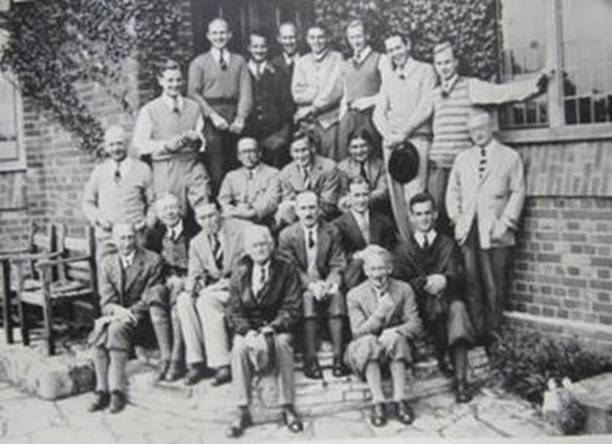
Beaumont Union Golf Society (BUGS) 1931
A Founder Society of the Halford Hewitt, their players were better noted in other fields than golf and included Ld Russell of Killowen, (Judge), Sir Charles Russell Bart, Hon Charles Russell (future Ld of Appeal) Sir George Langton (Judge), Sir Giles Gilbert Scott (Architect), Anthony Darnborough (Film Director)
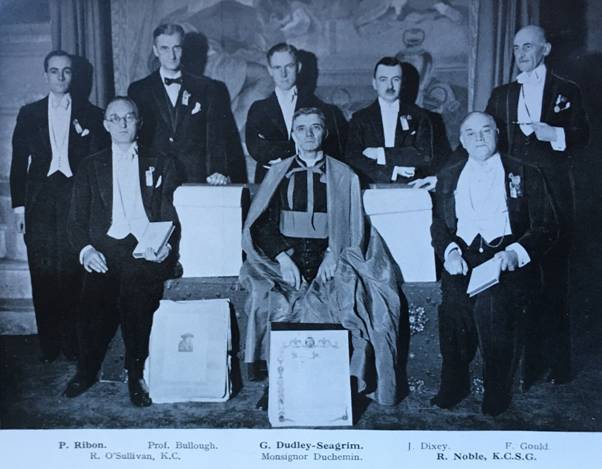
The Petition for the cause of The Canonisation of Bl. Charles More and Bl. John Fisher to The Pope March 1934. Under the signature of Ld. Russell of Killowen (OB) President of the Thomas More Society. Three OBs were part of the presentation Group. Philip German Ribon (Exeter Coll. Ox. Solicitor), Gerald Dudley-Seagrim (Christs Camb. Solicitor), Robert Noble (Oxford, Pres.Carlton Club. Inner Temple , Chief Justice St Vincent, Judge of Leeward Isles, KCSG)